More Discoveries for ‘Otto Ege Manuscript 41’
November 27, 2018 in Manuscript Studies, Photographic Exhibition
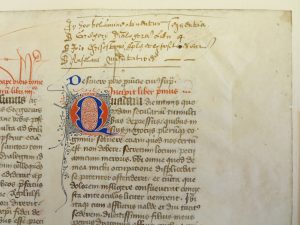 Otto Ege’s
Otto Ege’s
Dismembered Manuscript 41
A Latin copy of the
Dialogues of Gregory the Great,
Epistles and Homilies of John Chrysostom,
Meditations of Anselm,
And Maybe More
Double columns of 40 lines with some embellishment
Produced probably in Flanders, perhaps circa 1450
Plundered in World War I
From the Library of the Van der Cruisse de Waziers, near Lille in France
Sold circa 1925 through the Bookseller Thorpe in Surrey, England
Brought to the United States Intact, Then Dismembered and Distributed in Pieces
Continuing our series on Manuscript Studies, Mildred Budny (see Her Page) adds new evidence to her earlier reports of some leaves from medieval manuscripts dispersed by Otto F. Ege (1888–1951). Further research and newly revealed materials augment our knowledge of these manuscripts (and others).
This report updates our earlier blogpost on parts of Otto Ege Manuscript 41. See also the posts for Ege Manuscripts 8, 14, 51, and 61, plus updates (More Discoveries for Ege Manuscript 61), as well as the Report for our 2016 Symposium on ‘Words & Deeds’, with an illustrated Program Booklet.
This report, drafted following a first visit in 2017 to view examples in the Otto Ege Collection now at the Beinecke Rare Book and Manuscript Collection, benefits from updates following a new visit in October 2018, with my thanks for permission to examine and to photograph the materials, especially while they remain mostly uncatalogued.
Picking Up The Piecework
As more pieces of the manuscript come to light, and/or become recognized for what they are, the process of virtually picking up their pieces toward a reasonable reconstruction of their original contents can or must proceed piecemeal. More discoveries advance that process considerably. Here we report new stages. Some of them, naturally enough, may revise the received understanding about the manuscript.
The First Leaf & The Contents Listed, Medieval Style
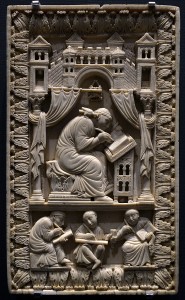
Ivory Plaque with Gregory the Great as Scribe Inspired by the Holy Spirit in the Form of a Dove. Vienna, Kunsthistorisches Museum (Inv. Nr. Kunstkammer, 8399), late 10th century, Lotharingia? Photograph by Vassil via Wikipedia Commons
The transfer of the treasure-trove of materials from the Ege Family Collection to the Beinecke Rare Book and Manuscript Library at Yale University brings into view significant evidence regarding many of the manuscripts which Otto F. Ege dispersed — as well as some manuscripts, mostly unknown, which miraculously remain more-or-less intact.
In some cases of dispersed manuscripts, the contents of the Beinecke trove can not only enhance, but also may reinforce, or even overturn, the hints, descriptions, and assertions about their nature, contents, and identities as presented by Otto Ege and other 20th-century accounts. Especially spectacular, for example, is the enlarged body of evidence which the trove contains for ‘Ege Manuscripts 14 and 51’ (see our updates, in preparation), in the forms of multiple leaves or multiple volumes (or remnants thereof).
In the case of Otto Ege Manuscript 41, an attractively decorated medium-format late-medieval copy of Christian texts in Latin by, or attributed to, Pope Gregory the Great (pope from 590‒604) and other notable authors, the Beinecke trove includes the first leaf of the original volume, with its elaborate opening page for Gregory’s text and a revelatory medieval contents list. The emergence of the first leaf and the contents list into scholarly view both enables and requires a clearer recognition of the original structure of the volume, before its dismemberment and dispersal as fragments — which have mostly disappeared beyond notice or recognition.
Standing in the upper margin above the right-hand column of text on the first folio (or leaf), the contents list, written in brown ink in a late-medieval hand, cites the set of texts in their sequence. It names three authors, aligned with one or more of their works — or purported works, given some difficulties with attributions over the centuries.
To an extent, the list clutters and perhaps defaces the opening page of Book I of Gregory’s Dialogues, but that location probably ensured the survival of the list, instead of, say, being discarded while on a seemingly superfluous, “uninteresting”, and extraneous endleaf, as the case with many other medieval endleaves. The potential value of the physical evidence on endleaves and bindings for our knowledge of medieval manuscripts, including their original production and history of use and/or abuse, is highlighted in A Scholar’s Plea.

Leaf 41, Recto, Top, in the Family Album (Set Number 3) of Otto Ege’s Portfolio of ‘Fifty Original Leaves’ (FOL). Otto Ege Collection, Beinecke Rare Book and Manuscript Library, Yale University. Photograph by Mildred Budny
The Contents Listed, 2oth-Century Census Style
While still intact, the manuscript received a brief account as part of Otto Ege’s collection, housed at 1888 South Compton Road, Cleveland, Ohio, when it was reported in the Census of Medieval and Renaissance Manuscripts in the United States by Seymour De Ricci and W. J. Wilson, Volume II (1937), at pages 1937–38. That Census of medieval manuscripts in Ege’s collection comprises a “selection, made by S. de Ricci and supplemented by more ample notes by W. J. Wilson” (page 1937). As a self-proclaimed “selection”, the report necessarily represents a partial, presumably compressed, and perhaps partly cursory set of observations.
The entry for Item 56 in Ege’s collection (at page 1945) surveys the manuscript, including its binding — apparently, alas, now lost, along with any endleaves. Because the report both supplies vital information and withholds some evidence for its interpretations, it should be viewed as it stands, in detail. Thus:
S. Gregorius Magnus, Dialogi, libri IV; S. Johannes Chrysostomus, Epistolae et expositionis in Epistolam ad Hebraeos, etc.; S. Anselmus, Meditationes. Vel[lum]. (early XVth c.). 274 ff[olios]. (31 × 22 cm.). Written in Flanders. Orig[inal]. wooden boards and stamped leather, with the Van der Cruisse de Walziers arms added.
Belonged ca. 1800 to Charles Van der Cruisse. — Obtained (ca. 1925) from Thorp, of Guilford. — This is apparently one of the mss. which disappeared during the War from the family library of the comte de Walziers, in northern France.
Not enough, we might think, in terms of information, but, let’s say, Something is Better Than Nothing. Now, let’s see what it’s worth.
3 Authors Assembled
Summing up these contents for convenience, there are 3 items, cited by author or purported author.
S. Gregorius Magnus, Dialogi, libri IV;
S. Johannes Chrysostomus, Epistolae et expositionis in Epistolam ad Hebraeos, etc.;
S. Anselmus, Meditationes.
That is:
Saint Gregory the Great, Dialogues, [in] IV Books
Saint John Chrysostom, Epistles and Commentaries on the Epistle to the Hebrews, etc.
Saint Anselm, Meditations.
According to this list, the volume carried works by, or attributed to, these authors:
- Pope Gregory the Great (540‒604 CE), Pope from 590‒604
- John Chrysostom (circa 349 – 407 CE), Archbishop of Constantinople, and
- Anselm (circa 1022 – 1109 CE), Archbishop of Canterbury.
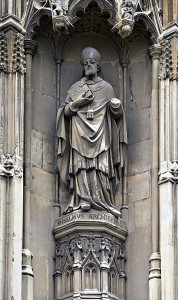
Saint Anselm, Archbishop of Canterbury, carved in stone by Theodore Phyffers (1821-1876) on the exterior of Canterbury Cathedral. Photograph by Ealdgyth via Wikipedia.
The list names in turn 3 major and prolific Christian authors, respectively from Early Christian Rome, Earlier Byzantine Constantinople, and the migratory Anglo-Norman realms — partly by way (in the Byzantine case) of translations from Greek into Latin. The combination is international in scope and focused broadly upon models and directions of guidance for pious devotion, comprehension, prayer, and practice.
On its own, without the chance to see the manuscript itself as a whole, the list of 3 different authors’ works might not indicate that the combination of texts comprised the product of a single, more-or-less unified, campaign of production. Many medieval manuscripts contain or comprise different portions which constitute distinct, different components, or self-contained ‘booklets’, produced at different times, in different centers, in different styles of script, format, layout, and forms of embellishment, and by markedly different scribal and artistic approaches.
So far, the recognized leaves from Ege’s dispersed manuscript of the Dialogues and other texts reveal a similar, accomplished approach to the pages, apparently as the work almost entirely of the same scribe(s) and decorator(s). These leaves exhibit the same scripts for the main text, chapter lists, titles, and opening initials for important textual divisions (Books, Chapters, Epistles, Sermons) — including a penchant for extravagantly extended ascenders in the top lines of the columns and the consistent application of an interlocking puzzle-style formation for the principal initials, rendered in bichrome blue-and-red pigments with infills and extensions in the form of extended pen-flourishes.
The style is both distinctive and recognizable. Thus, so far, it appears that both the ‘Gregory’ and the ‘Chrysostom’ portions maintained a consistent style and layout. Unless and until any parts of the ‘Anselm’ portion emerge into view, we cannot know how, or if, it conformed with the original production or added on some other unit, whether as an inserted set of leaves with its text(s) or as some text(s) entered upon available leaves at the back of the book.
The Chrysostom Connection
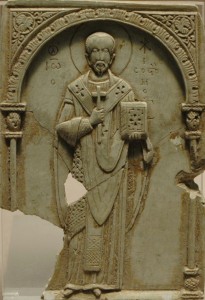
Soapstone Relief of Saint John Chrysostom, 11th Century. Louvre Museum. Photograph Photograph © Marie-Lan Nguyen (Jastrow) via Wikimedia Commons.
The other authors’ items name one work alone. The middle portion, perhaps or probably occupying the lion’s share of the volume, lumps together a bunch of them, in a tantalizingly open-ended way.
On its own, the element ‘etc.’ for the block of ‘Chrysostom’ texts in the 1937 Census entry leaves unclear what it covers. Given what we might know elsewhere of the oeuvre, factual or purported, that term could denote:
- more works from Chrysostom’s vast body of writings translated from Greek into Latin by one or various authors over the centuries, in one and/or another version of the Chrysostomus Latinus (“the Latin Chrysostom”),
- some other works attributed to him, by way, say, of a Greek or Latin Pseudo-Chrysostom,
- and/or from works by some other author(s).
That is, the phrasing for this portion of the contents might variously imply
- more of Chrysostom’s own known or purported Epistles, as in ‘Letters’ (to various named recipients, male and female)
- some of Chrysostom’s Commentaries (in the form of Sermons) on more of the Pauline Epistles by, or attributed to, Paul the Apostle (circa 5 – circa 67 C.E.) than solely the Epistle to the Hebrews
- and/or Chrysostom’s Commentaries on more of the Books of the Bible (Old and New Testaments included)
- works by some other author(s)
- or a combination of these.
Among Chrysostom’s extant Bible Commentaries (AKA ‘Sermons’ or ‘Homilies’), there figure 67 homilies on Genesis, 59 on the Psalms, 90 on the Gospel of Matthew, 88 on the Gospel of John, 55 on the Acts of the Apostles, and 216 on the Pauline Epistles overall, with 34 on the Epistle to the Hebrews alone. Not to mention the possible confusion or conflation between Epistles meaning Chrysostom’s ‘Letters’ as such, or Epistles within the Books of the Bible, for which Chrysostom provided commentaries (see above).
As more leaves from the dispersed manuscript emerge, some of these variables become clarified. As revealed here.
The author(s) of the 1937 Census description had the benefit of seeing the book itself, and perhaps an attached description by the bookseller Thorpe. They might reasonably, but short-sightedly, have assumed that their description would accompany the intact object, but we must view it with a hightened form of scrutiny, because we have to cope with the dispersal and destruction of the contextual evidence.
And so, as usual, we cope with the material evidence, insofar as we can find it. On the bright side, as usual, we might be work some wonders with a paucity of materials.
Before we turn specifically to the textual contents of the volume, as reported variously by the Census, the medieval contents-list, and the testimony of surviving leaves, we should consider the evidence of the Census for the ownership and transmission of the volume comprising “274” leaves and an “original” binding. The recognized leaves carry no page- or folio-numbers, which impedes the progress of recognition and more-or-less accurate reconstruction — in contrast to, for example, some other Ege Manuscripts, including ‘Ege Manuscript 51’ (having more than one set, which makes things interesting, or, shall we say, differently interesting).
Provenance and Transmission
To judge by the Census description, the binding carried the Van der Cruisse de Waziers arms in some form, as found on other volumes in the family library, which has been dispersed. The characteristics of the ‘stamped’ pattern remain unknown. An “original” binding for a decorative, but non-sumptuous, volume containing texts for consultation and study rather than, perhaps, for recitation or performance, might not have qualified for inclusion in the 1874 exhibition at Lille of ‘douze manuscrits remarkable pour leur reliure’ (numbers 132—144, with their identity unspecified) in the collection of ‘M. Van der Cruisse de Walzers, Lille’, as recorded in the Catalogue de l’exposition d’objets d’art religieux (1874), page 45.
The reported name of “Charles Van der Cruisse” presumably appeared within the volume in some way, whether as owner or inscriber (or both), along with some sign(s) or other to show or to suggest a date-range of “ca. 1800”. The printed funerary oration for Charles-Michel-Hugues-Joseph van der Cruisse de Waziers (1785‒1862) gives some some indication of the person and his traits. His position within his family tree appears via www.geanet.org. If it is this individual, and if the cited date-range of “ca. 1800” has any substance, apart from, say, an approximate evaluation of the style of script, then the entry or entries would belong to a teenager’s. As such, or if so, then his entry/entries could belong to the plentiful genre of childish scribbles or stray additions to a book within an existing library. And not so much to an owner’s declaration.
At any rate, the reported presence of his name in some form and/or other within the volume provides a date-range at the latest for its arrival within the family library. Worth observing that the book could have arrived sooner — as a juvenile’s entry, if such it is, might well imply.
Note to Cataloguers (Self Included): Precision helps future scholars and students. Even if what you see is obvious, perhaps there is no reason to assume that others following you will be able to see the same. Destruction of manuscripts being what it is, market considerations included.
To put it plainly, imprecision pollutes and confounds the chances of understanding what’s what. Especially when the evidence and its context have disappeared. Wish we knew what form(s) and context(s) that Charles’s name took in the book. Wish we knew what the binding looked like. Etc.
Alas, the version of the family arms on the lost binding could have provided further, or better, evidence of the date-range of acquisition and ownership by that bibliophilic family. We know, even if De Ricci and Wilson did not, that those arms had various versions, naturally enough, as different individuals carried them (as some bindings demonstrate). There are many reasons, these included, for regretting the lost of the original binding and any endleaves, let alone the other leaves of text which have disappeared from view.
Examples of identified extant volumes from that family library include a collection of early printed texts, now in Paris, owned by Charles’s grandfather, Arnoul Hughes Joseph Van der Cruisse (1712-1783). That volume reached its present library now in Paris already circa 1800, at about the same time supposedly as young Charles was making his entry or entries in the family’s medieval manuscript of pious texts by Gregory and others.
It is sobering to recognize that only a small portion of the “274” reported, but unnumbered, leaves from Ege’s Census Manuscript of the Dialogues etc. have been identified. Who knows what further evidence the others may (have) contain(ed)?
A Plundered Library
The sumptuous library of the Van Der Cruisse de Waziers family was formerly housed in the Château du Sart at Villeneuve-d’Ascq near Lille (Département du Nord), France. That library was plundered during World War I.
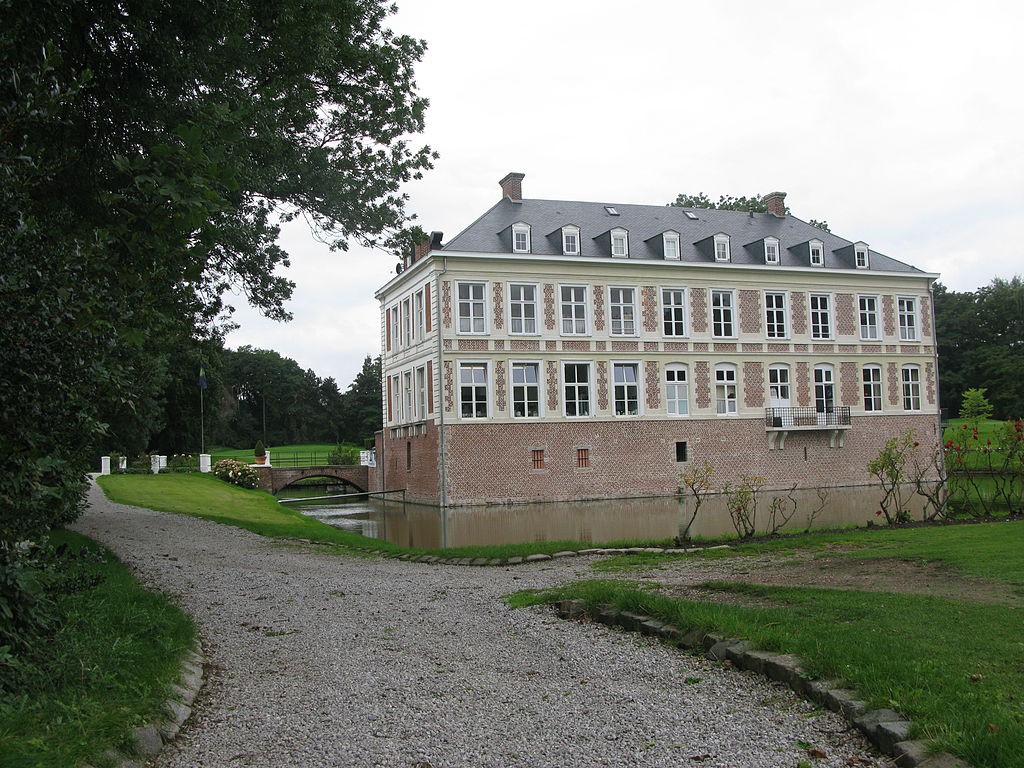
Château du Sart, seen from the South. Former home of the library of the Van Der Cruisse de Waziers family. Photograph by Jiel Baumedier via Wiki Commons.
An account of the fortunes and misfortunes of the library was published by E. Olivier, ‘La bibliothèque Van der Cruisse de Waziers’, in the Archives de la Société française des collectionneurs d’Ex libris et de reliures artistiques (November, 1925), pages 115–119. (After searching for this printed source in vain for some time, I have been able to see it, thanks to the generous archival expertise of our Associate, Linde Brocato.) It includes illustrations of the family arms found on bindings in 3 different forms, as well as some ex-libris book-plates naming specific family owners. It reports stages in the history of the library, including the descent of its ownership from father to son across generations, some remarkable volumes in print and manuscript, and events by turns surrounding, restraining, or enabling the plunder of many volumes under German occupation in 1914–15.
A poignant plea for the plundered books, both manuscript and printed, being sold on the open market appears in the detailed list of 12 ‘Manuscrits disparus en 1915 près de Lille pendant l’Occupation’ published anonymously in the Bibliothèque de l’École des chartes, 92 (1931), page 252:
On a récemment signalé plusieurs offres de vente, qui ont été faites en France et à l’étranger, de différents manuscrits et incunables disparus au cours de la dernière guerre de l’une des plus importantes collections privies du nord de la France, la bibliothèque Van der Cruisse de Waziers, conservée au château du Sart, près Lille. La liste sommaire de ces volumes, qui vient de nous être communiquée et que nous reproduisons, pourra permettre de les identifier.
But by then, the Dialogues volume had already, still bound and intact, passed into the biblioclastic hands of Otto F. Ege in or circa 1925 through the English firm of Thomas Thorpe, bookseller, founded in 1883 in Reading in the United Kingdom and based in Guildford in Surrey (and elsewhere) until it closed in 2003.
A Dismembered Manuscript
The manuscript remained whole until, at least, the preparation — but not necessarily the publication — of its description for the Census published in 1937. Upon dismemberment, which may or probably occurred in stages, it circulated as specimen leaves either in one of Ege’s Portfolios or Leaf-Books, in the company of 49 other specimens from medieval manuscripts, or on their own (or in individual groups) as ‘Rogue Leaves’. These patterns are described in our earlier blogposts about Ege Manuscripts and their distribution in various ways. (See our blog’s Contents List.)
I. The Portfolio of Fifty Original Leaves (‘FOL’) and Its Leaf 41
Specimen leaves (usually single leaves) from this manuscript take their place in Ege’s Portfolio of Fifty Original Leaves from Medieval Manuscripts, Western Europe, XII–XVI Century (‘FOL’), where it comprises Leaf Number 41. Other leaves, known as ‘Rogue Leaves’, circulated on their own, sometimes within, or still within, Ege-style mats. An account of the FOL Portfolio and that specimen Leaf within it, as known from some identified survivors, appears in our earlier blogpost reporting A New Leaf from ‘Otto Ege Manuscript 41’.
The FOL Portfolio occurs in mostly numbered sets (1–40), albeit with at least 1, or more, perhaps unnumbered. It comprises a clamshell-style box which encloses a stack of loose folders, 1 per specimen Leaf, accompanied by a 1-page contents list printed on a single sheet. A partly-printed and partly-handwritten label on the inside front cover of the box gives the number of the individual set.
Within the stack, each folder comprises a folded pair of sheets with a windowed front, custom-sized for the leaf-in-question, and a plain back. To the back sheet is taped the specimen manuscript leaf (or rarely, and surprisingly, a pair of leaves in the form of a bifolium). Depending upon the position of the tapes, the hinging might sometimes permit an easy hinged turning of the leaf, so as to reveal the back in full, or impinge a ready access.
Consulting this Portfolio in one or another of its current locations brings the first view of its clam-shell box, folio-size, and sometimes bearing signs of wear, as on the Ege Family Album. That set carries the number 3 in the numbered set of 40 Portfolios. Viewed here from the front and side:

Front and Side of the Family Album (Set Number 3) of Otto Ege’s Portfolio of ‘Fifty Original Leaves’ (FOL). Otto Ege Collection, Beinecke Rare Book and Manuscript Library, Yale University. Photograph by Mildred Budny.
Opening the Portfolio reveals a stack of loose folders, 1 per specimen Leaf, accompanied and topped by a 1-page contents list printed on a single sheet. This set contains 2 copies of the contents list, 1 followed by the other. The ensemble presents an impressive stack.

Interior View of the Family Album (Set Number 3) of Otto Ege’s Portfolio of ‘Fifty Original Leaves’ (FOL). Otto Ege Collection, Beinecke Rare Book and Manuscript Library, Yale University. Photograph by Mildred Budny
Take a moment to note the Number of the Set, indicated on the printed Label.

Number 3 (of 40) in the FOL Portfolio. Otto Ege Collection, Beinecke Rare Book and Manuscript Library. Reproduced by permission. Photography by Mildred Budny.
In the form of a “Chronological Index”, Ege’s contents list for the Portfolio describes Leaf 41 simply as
“France: Dialogues of Gregory the Great“.
Only sometimes it’s not, that is, Gregory’s Dialogues (or any other text by Gregory), because it belongs to a different part of the manuscript and to some other author’s or authors’ work(s). (See Above and Below.)

Contents List for the Family Album (Set Number 3) of Otto Ege’s Portfolio of ‘Fifty Original Leaves’ (FOL). Otto Ege Collection, Beinecke Rare Book and Manuscript Library, Yale University. Photograph by Mildred Budny.
Within the Portfolio, the specimen leaf is presented in its own folder, comprising a matted paper frame with a window narrower than the leaf, cropping it partly from view, and an attached printed label offering a generic description. Sometimes it fits, often it doesn’t. And its legacy of confusion proliferates.
However, let’s clear the field. Can do.
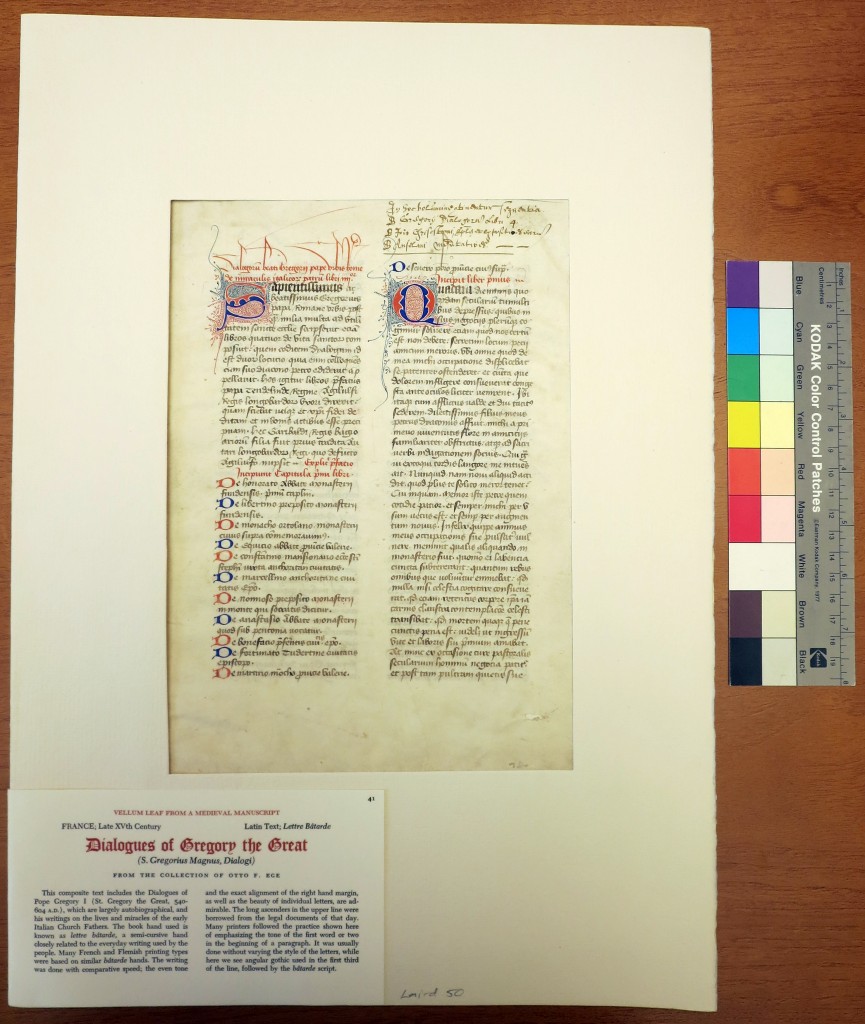
Leaf 41 within its Mat with Printed Label in the Family Album (Set Number 3) of Otto Ege’s Portfolio of ‘Fifty Original Leaves’ (FOL). Otto Ege Collection, Beinecke Rare Book and Manuscript Library, Yale University. Photograph by Mildred Budny.
The Beinecke Recto Unveiled
The first leaf of the manuscript reveals its unevenly severed inner margin, roughly removing the leaf (and its former companions) from the stitching. The opening page of text presents a pair of elaborate jig-saw-style bichrome red-and-blue 4-line initials both enclosed by and filled with penline flourishing in alternate sections of red and blue ink. Rubricated titles in 1 or 2 lines introduce the sections of text, beginning with the opening title.
Dialogorum Beati Gregorii pape urbis Rome de miraculis italicorum patrum libri IIIIorum.
That is,
Of the Dialogues of the Blessed Gregory, Pope of the City of Rome, Concerning the Miracles of the Italian Fathers, in 4 Books.
Looking at the page, there follows a brief Prologue to the Dialogues, with bits of historical information naming Langobard/Lombard royalty, including Queen Theodolinda (circa 570-628 CE), King Agiluf (circa 555 – 616), and King Garibald (reigned 671).
This Prologue does not belong to the Dialogues as such, but derives from some other texts, including a passage in the Historia Langobardorum, Book IV.4, by Paul the Deacon (circa 720 – 799 CE). Its biographic (not autobiographic) or bibliographic form of prologue belongs in the prevalent category of medieval Accessus ad auctores (or “Introductions to Authors”). They provide brief, sometimes juicy, guides to the text in hand. Not all copies of the Dialogues saw fit to include this preface, or such a preface. Gregory’s own prologue for the Dialogues occupied a slightly but significantly different place, concentrating upon the Books themselves.
Next comes the Chapter List for Book I, in 12 unnumbered Chapters. It both fills the rest of the left-hand column (column a of a–b) and runs over into the right-hand column (column b) in 1 final line. There directly follows Book I, with its opening title Incipit liber primus (“[Here] Begins the First Book”) and its opening initial Q for Quadam die (“On a certain day”), which begins Gregory’s autobiographical Prologue for Book I.

Recto of Leaf 41 in the FOL Portfolio. Otto Ege Collection, Beinecke Rare Book and Manuscript Library. Reproduced by permission. Photography by Mildred Budny.
The Beinecke Verso Unveiled
The verso continues the text of the Prologue, reaching nearly to its end, before breaking off abruptly mid-phrase (per singula / [quae describo]). I haven’t yet identified the next leaf among any survivors from the manuscript, so I don’t know if or where it survives. We look for a leaf in this style of script and format and layout beginning with the words quae describo etc. of Gregory’s Dialogues, Book I, Prologue and Chapter I. It could be not be too much to expect that this leaf would present the opening of Chapter I with an elaborate initial V for Veniantii (“Of [the patrician] Venance”).

Verso of Leaf 41 in the FOL Portfolio. Otto Ege Collection, Beinecke Rare Book and Manuscript Library. Reproduced by permission. Photography by Mildred Budny.
Meanwhile, we observe that the presentation of the dialogue structure on the Beinecke leaf names in full, and in red ink, the different speakers, introducing their questions-or-answers: Peter the Deacon (Petrus) and Gregory (Gregorius). In the right-hand column (column ‘b’ of columns ‘a–b’, progressing from left to right), the different speaking parts, written in the standard brown ink, leave place for an enlarged red or blue initial, amd pause within the lines of text to allow the insertion in red ink of the different speaker’s names. Suffice it to say that this careful practice did not, apparently, extend far or consistently into most of the text, to judge by the other known leaves.
An example. In this next specimen, do you see the gaps left for the speaker’s names to be inserted in red ink? This portion, now in Cincinnati (FOL Set Number 9), leaves gaps, unfilled, for the required names of Petrus (beginning with the word Valde), Gregorius (beginning Hoc), and Petrus (beginning Placet) in the lower lines of the right-hand column on the recto (line ra).
Cincinnati Ege Leaf 41, recto. From the Collection of The Public Library of Cincinnati and Hamilton County. Reproduced by permission. Photograph by Mildred Budny.
In some other portions of the text, the scribe did not even bother to skip a part of the line to allow for the insertion of the speaker’s name in the dialogue structure. (See below.)
Such signs tell us about the stages of production, and the degrees of care (or not) which the scribe manifested in the progress of work on the production. Telling, don’t you think?
So glad to see these newly revealed portions of the book!
Otto Ege’s View of the Manuscript’s Specimens
The specimens of Leaf 41 distributed among the Portfolio sets — and sometimes on their own within individual matted frames — were accompanied, and introduced, by Ege’s printed caption, shown here from Set Number 9 (in Cincinnati). The label offers some observations, although not exactly rigorous or precise regarding either the manuscript or the individual leaf.
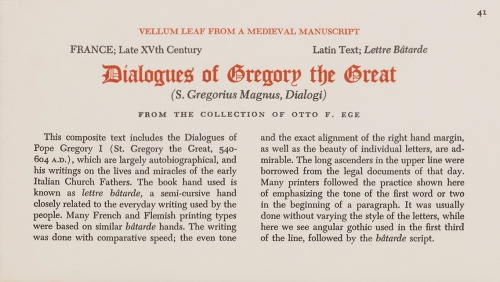
Otto Ege’s printed Caption for Leaf 41 in the FOL Portfolio. From the Collection of the Public Library of Cincinnati and Hamilton County. Reproduced by permission.
Our earlier blogpost has considered the merits and otherwise of Ege’s description. For convenience, we transcribe it again. In his words:
This composite text includes the Dialogues of Pope Gregory I (St. Gregory the Great, 540-604 A.D.), which are largely autobiographical, and his writings on the lives and miracles of the early Italian Church Fathers. The book hand used is known as lettre bâtarde, a semi-cursive hand closely related to the everyday writing used by the people. Many French and Flemish printing types were based on similar bâtarde hands. The writing was done with comparative speed; the even tone and the exact alignment of the right hand margin, as well as the beauty of individual letters, are admirable. The long ascenders in the upper line were borrowed from the legal documents of that day. Many printers followed the practice shown here of emphasizing the tone of the first word or two in the beginning of a paragraph. It was usually done without varying the style of the letters, while here we see angular gothic used in the first third of the line, followed by the bâtarde script.
The caption reasonably enough describes the text of the book as ‘composite’, but it specifies only Gregory’s Dialogues — even though the specimens distributed in some sets of the Portfolio (including Sets Numbers 25, 29, 30, 35, and 37) or on their own only contain others’ texts instead. The caption also presupposes the inclusion of a leaf which held an opening initial of some Book or Chapter or Text or other, but that does not always pertain to the specimens included in the FOL Portfolio. (See below).
Bait and Switch? You Bet. Who Could Tell, and Who Would Care? I for One.
Time might tell, but so far I have not identified which leaf or leaves Ege specifically had in mind, and before him, as he composed the description. The form of script for the main text, with long ascenders in the first line of the columns, pertains to all the leaves which I have seen from the manuscript. It appears to be a characteristic of the scribe’s approach to the pages.
But the specified elements not found on all leaves comprise the use of Gothic script “in the first third of the line” (whichever line on the page that might be) and the habit of “emphasizing the tone of the first word or two in the beginning of a paragraph”. In my earlier report, I thought I knew what he meant by “tone”, but further exploration and reflection encourage me to rethink.
Here’s what I mean.
Ege’s caption confusingly describes practices not found on all of the specimens, but presumably only on whichever one(s) stood in view during his composition of the caption. An extra kicker is presented by his workshop’s habit, when matting and framing the individual leaf, of turning one side or another into prominence, forcing us to peer through the window, regardless of its position in the original manuscript as a recto or verso.
Ege’s mention of the “practice shown here [emphasis mine] of emphasizing the tone of the first word or two [ditto] in the beginning of a paragraph” perhaps refers to the color of an opening initial itself, followed by some enlarged letters in the customary ink, before settling down into the standard text script. It could refer to the simply enlarged and colored initial of a minor section on some pages, mostly or only in the Dialogues. Or it could signal the wash of yellow color added within some ink initials in the Chrysostom portions (see below). If it means the yellow wash, then Ege was looking at a part of the book which did not pertain to the Dialogues.
This I say after (since my first blogpost on this dismembered manuscript) after looking at more of its fragments, containing other than Gregory’s texts. First, because of the focus on a fragment which had come into my view, thanks to its collector, I addressed my research on the portions of the original volume which contained Gregory’s Dialogues. As indicated and explored in my first blogpost on this book. \
As for ‘Tone’
I’m still not sure that I know what Ege meant, but I come to recognize that his word ‘tone’ might not mean ‘color’, as I had assumed. What if he intended a ‘weight’ or ‘register’ in terms of the ‘font’? That might work, perhaps.
Witness our official font Bembino.
Similarly, not all specimens follow the stated rule that ‘here we see angular gothic used in the first third of the line, followed by the bâtarde script’. Some pages have no such initials or opening lines. Etc. Did I mention that it can be frustrating?
Date(s) of Dismemberment
The precise date(s) of issue of the FOL Portfolio remain(s) uncertain or variably reported. For example, the “Checklist” by John P. Chalmers in Christopher de Hamel, Joel Silver, et al., The Leaf Book Considered (2005), number 51 (page 114), cites the range as “1930–1950”. However, the Sale Catalogue of 101 Original Leaves & Sets of Leaves from Medieval Manuscripts, Incunabula, Famous Bibles and Noted Presses, 1150 A.D. – 1935 A.D. offered by Otto Ege in 1944 through the Lima Public Library Staff Loan Fund lists a leaf, priced at $2.00, from the manuscript:
58. 1500 A.D. FRANCE. Pope Gregory’s Miracles of Early Italian Fathers. Vellum leaf (12 × 9 inches). Written in bâtarde, or semi-cursive French Gothic script, double columns, 40 lines to the page, with colored initial letter.
This catalogue is reproduced in Scott Gwara, Otto Ege’s Manuscripts: A Study of Ege’s Manuscript Collections, Portfolios, and Retail Trade, with a Comprehensive Handlist of Manuscripts Collected and Sold (2013), figures 41–48 (pages 253–260), with catalogue number 58 appearing in figure 45 (Gwara’s page 257). The description of Gregory’s text in the item as “Miracles of Early Italian Fathers” suitably encapsulates, in English, the character and contents of the Latin Dialogues.
That is, if that text is what the listed leaf contained. Doubt is not only permitted, but also required, given the circulation of individual leaves described as that work, even when it is clear that they contain other texts altogether, albeit written by the same scribe in the same style, demonstrating that they belonged to one original manuscript. Of course, if other leaves from the same book were written by other scribes in other styles, it could be very difficult to identify them as such. Also, it is fully possible, pending evidence to the contrary, that the item called it a “leaf” in the singular, but may have intended that all-purpose description for more than one of them, each on its own.
Experience shows that not all the leaves which circulated from the manuscript under that description (see below) belonged to its portion with Gregory’s Dialogues. Who cares, huh? Once you’ve seen one leaf in bâtarde script, you’ve seen them all, right? Amiright? Yeah, right.
II. Sales Records

Otto Ege Manuscript 41. Opening of the Book of Zachariah. Courtesy of Flora Lamson Hewlett Library, Graduate Theological Union, Berkeley, CA. Reproduced by permission.
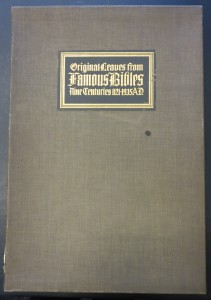
University of Pennsylvania Libraries, Special Collections, Portfolio Bible 1 (Catalogue ID 6035076), Album Front Cover. Photograph by Mildred Budny.
Perhaps sometime that leaf, or those generic leaves, from the Lima Public Library Sale Catalogue may be identified (if it/they survives/survive). Recently there has come to light such a leaf detached from another Ege Manuscript, as reported in our blogpost on More Discoveries for ‘Otto Ege Manuscript 61’. Fortunately in that case, the clipping from the Sale Catalogue was retained along with the leaf. By chance, I recognized the connection, when its current library sent me an uncropped set of higher resolution images of recto and verso of its leaf for inclusion in that blogpost. Bingo!
The trimmed remnants of an Ege-style mount with red ruled lines and the sales clipping clinch the connection with a formerly mounted leaf issued through the Sale. According to the clipping, that item, Number 26, carried the price of $20.00, reflecting a higher evaluation of its decoration and especially of its illustrated initial with an image of the prophet Zacharias, which stands on the original recto of the leaf. That feature not only established a figure for the price, but also set the leaf in an illustrious category positioned above most (or all?) of the leaves dispersed from ‘Ege Manuscript 61’ in its sets of Portfolios showcasing specimen leaves from Original Leaves from Famous Bibles, Nine Centuries 1121–1935 A.D. , issued in 2 series or versions (with some variations).
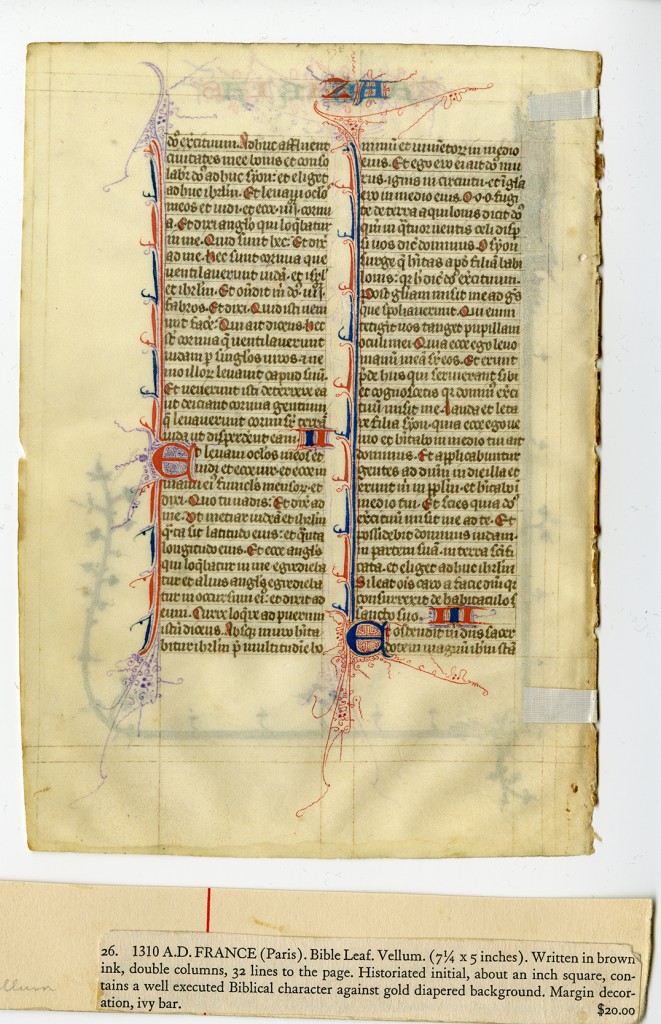
Verso of Leaf Opening the Book of Zachariah, plus Clipping from its Sale Catalogue. Courtesy of Flora Lamson Hewlett Library, Graduate Theological Union, Berkeley, CA. Reproduced by permission.

Ege Manuscript 41, Dialogues of Gregory the Great, Book III, chapter 13 initial. Private collection, reproduced by permission
In the case of Ege Manuscript 41, the mention of a “colored initial letter” for Item 58 in the Sale Catalogue implies that the leaf in question contained an opening of one of the Books, Chapters, or Texts — whether it might have been one of Gregory’s or another of the volume’s authors’. The stated price clearly indicated that the colored initial belonged among the lesser, rather than the major, decorated initials in the range which the recognized survivors embody. An example of the lesser sort (if we have to regard such evaluations as valid) appears on the “New Leaf” which forms the subject of our earlier blogpost. Here, at the right, you may see its skillful initial N for Nuper (“Recently”) of Gregory’s Dialogues, Book III, Chapter 13.
Such evidence indicates that, in the case of Ege Manuscript 41, the process of dismemberment had begun in time for the Sale Catalogue of 1944, nearly twenty years after Ege’s acquisition of the book, but within a decade of his death. Although perhaps or probably the dismemberment had started earlier. It seems probable that the selections for the FOL Portfolio had begun before the single or multiple ‘rejects’ or ‘decorative’ selections found its/their listings in the Sale Catalogue.
The Best for Lasting
Now that the residue of Otto Ege’s collection of manuscripts and other materials has been acquired by the Beinecke Rare Book and Manuscript Library, and — with thanks to the Library Staff — some glimpses of its treasures become possible by a scholar already before the whole Otto Ege Collection has been processed, we can see more of the range . . .
It is evident that the Family Album of Ege’s Portfolio of Fifty Original Leaves from Western Medieval Manuscripts (considered in some earlier blogposts) contains some choice leaves from the manuscripts dismembered for distribution thus — as well as by some other ways, single leaves and larger residues included. According to a signed and dated note kept with the Family Album, 2 of the Specimen Leaves are missing, the Family Album’s leaf from Ege Manuscript 41 is no exception to the observable rule that this Family Album could be expected to contain some of the best.
The Family Album
Seen here from both the the outside and the interior, the Family Album has the characteristic clamshell box, the printed and numbered Label for which Set it holds within the Limited Edition (of 40 numbered sets), the single-sheet printed Contents List, and the stack of separately mounted and labeled Specimens. Entered by hand on the printed Set Number Label which stands affixed to the inside front cover of the Album at the lower right-hand side. This Set has the Number 3.
The FOL Portfolio, in mostly numbered sets (1–40), has a clamshell-style box which encloses a stack of loose folders, 1 per specimen Leaf, accompanied by a 1-page contents list printed on a single sheet.
In the form of a “Chronological Index”, Ege’s contents list for the Portfolio describes Leaf 41 concisely as:
“France: Dialogues of Gregory the Great“.
Only sometime’s it’s Not.
Within the Portfolio, the specimen leaf is presented in its own folder, comprising a matted paper frame with a window narrower than the leaf, cropping it partly from view, and an attached printed label offering a generic description. Neat.
The Medieval Contents List
The list of texts at the front of the manuscript itself is short and sweet, so to say.
Expanding its abbreviations, the Latin reads:
In hoc voluminum continentur sequentia.
Beatus Gregorii Dialogorum Libri 4.
Beatus Johannis Cristostomi, Epistolas et Expositiones earum
Beatus Anselmi Meditationes. — —
In English translation:
In this volume are contained the following [texts].
Saint Gregory’s Dialogues [in] 4 Books.
Saint John Chrysostom’s Epistles and Their Commentaries
Saint Anselm’s Meditations. — —
The cast of authors, as listed:
- Pope Gregory the Great (540–604 CE), Pope from 590‒604
- John Chrysostom (circa 349 – 407 CE), Archbishop of Constantinople from 397–404
- Anselm (circa 1022 – 1109 CE), Archbishop of Canterbury from 1093–1109
Thus, instead of one author, as Ege’s catch-all term “Dialogues” implies, we have at least 3 named in the contents list.

Saint Anselm, Archbishop of Canterbury, carved in stone by Theodore Phyffers (1821-1876) on the exterior of Canterbury Cathedral. Photograph by Ealdgyth via Wikipedia.

Soapstone Relief of Saint John Chrysostom, 11th Century. Louvre Museum. Photograph Photograph © Marie-Lan Nguyen (Jastrow) via Wikimedia Commons.
[CUT
The Census description of the volume by De Ricci and Wilson appears to have depended in no small measure upon this version of the contents — or one very similar. However, their description specifies that, for Chrysostom, the Epistles and Commentaries represented those for the Apostle Paul’s Epistle to the Hebrews. Chrysostom’s Homilies on that Epistle alone comprise a set of 34. Perhaps that subtle, but significant difference, demonstrates a vision of the volume deriving from a somewhat different account of the contents already preset within its span.
A similar witness to the contents, medieval or other, could have stood elsewhere at the front, say on an endleaf or pastedown, or have appeared in the bookseller Thorpe’s description. As with some other medieval contents-lists, this one entered at the front on the first leaf of text might summarize, rather than fully itemize, the authors and the titles of all the texts. Inspection of the full book would have established the case here, but the dismemberment has rendered such precision difficult of access, to say the least. Troublesome, that sums up the predicament.
I. Saint Gregory’s Dialogues in 4 Books
A popular author throughout the medieval period (and beyond), Gregory the Great received various images or ‘portraits’, including generalized or idealized images. There is no question that Ege’s copy did not contain any such image of that author, or any of the other authors in the compilation, because the Census description mentioned no such thing. Besides, most of the extant medieval images of Gregory — in manuscript, book covers, or other media – belong to other texts by, or attributed to, him.
We may turn to other resources for medieval views of a popular and revered author — even if he might not really have been the author of the Dialogues. That dispute still has adherents, but we can remain apart from that fray, while we concentrate upon the manuscript in question.
Gregory’s Dialogues enjoyed a wide circulation in the Middle Ages. It told stories. Who doesn’t like stories? Fact and lore about the lives and deeds of saintly individuals active in the early-Christian period in Italy. What’s not to love?
In its transmission across the medieval period, its manuscript formats appeared in many shapes and sizes. Many of the extant manuscripts are listed and concisely described in the critical edition (in 3 volumes) by
- Adalbert de Vogüé (1924–2011), with a facing translation in French by Paul Antin, in Grégoire le Grand, Dialogues, within the series Sources Chrétiennes, volumes 251, 260, and 265 (Paris, 1979)
Another bilingual critical edition, based upon a few manuscripts and some printed editions, with facing translation in Italian, is offered by
- Salvatore Pricoco (responsible for the Introduction and Commentary) and Manlio Simonetti (responsible for the Critical Edition and Translation), in Gregorio Magno, Storie di sante e di diavoli (Dialoghi), within the series (unnumbered) Scrittori greci e latini, 2 volumes (2005–2006)
None of the listed manuscripts in these editions includes Ege Manuscript 41. No wonder. Ege’s destructive activities rendered it out of the running. Beyond recognition, remember? It could be that its text is unremarkable. But it didn’t have a chance. Some day its standing within the complex transmission of the text might assume its rightful place, even if perhaps negligible. We deserve to know.
To the company of the extant witnesses to Gregory’s text must be added Ege’s dismembered manuscript, although its dispersal and incomplete recognition renders difficult — to say the least — an ability fully to assess the quality, or otherwise, of its character as witness to the text in its transmission through the late Middle Ages in Northern Europe.
Meanwhile, it seems already clear that the surviving leaves, as so far identified, show that Ege’s manuscript contained the full text of the Dialogues, as implied by the medieval contents list. So far, the leaves which I can identify from the Dialogues extend into Book IV, which comprises 59 chapters. They extend so far up to within Chapter 4, in a leaf now at Kenyon College. Maybe more leaves from the rest of that Book, including its last leaf, might turn up.
Who knows, that leaf might show a crucial transition between Gregory’s text and the next, say with a concluding title and an opening title. A Girl Can Dream.
II. Saint John Chrysostom’s Epistles and Their Commentaries, “Etc.”
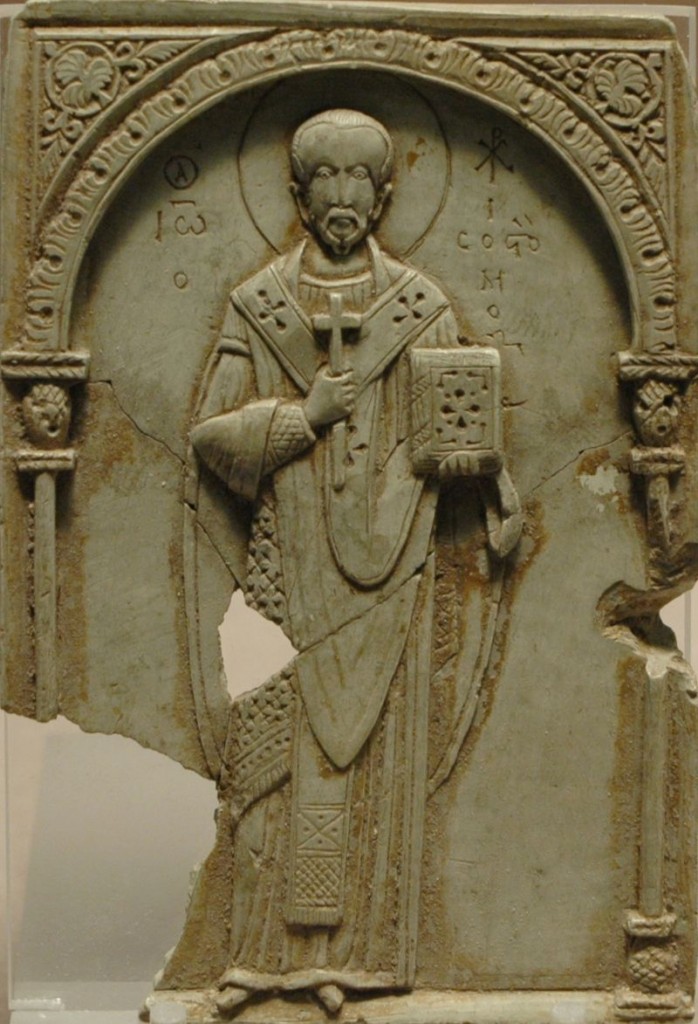
Soapstone Relief of Saint John Chrysostom, 11th Century. Louvre Museum. Photograph by Jastrow (2005) via Wikipedia Commons.
The Epistles Commentary in question, so far as the recognized leaves of Ege Manuscript 41 demonstrate, apparently mostly pertains to Chrysostom’s Commentary or Homilies on the Epistle of Paul to the Hebrews — that is, in a Latin translation customarily attributed to Chrysostom. More work on this subject awaits. Previously, for our first blogpost on the manuscript, I concentrated on the Dialogues. Now I am ready to look at its Homilies attributed to Chrysostom, for a next stage.

Statue of St. Paul the Apostle by Pierre-Étienne Monnot. Rome, Basilica of Saint John Lateran, Nave. Photograph © Marie-Lan Nguyen via Wikimedia Commons.
Chrysostom’s Homilies overall number in the hundreds, as collected, for example, here. He devoted an impressive series, or set of series, to the Pauline Epistles, attributed to the Apostle Paul the Apostle (circa 5 – circa 67 CE) and addressed to various audiences, comprising the Hebrews and others. This part of Ege Manuscript 41 represents, purportedly, a major Early Eastern Christian Author’s take on parts of a major Earlier Christian Author’s oeuvre.
However, one or more leaves from the Chrysostom portion of Ege Manuscript 41 do not belong, apparently, to that set of texts, nor to the other authors’ texts cited in the medieval contents list. At least insofar as some library cataloguers have stated, they carry text corresponding to the Homilies of Saint Augustine of Hippo (354–430). It is worth observing that resources available, by subscription or otherwise, entail that scholarly editions could be accessible to cataloguers in some institutions, and not to others.
So far, I have concentrated on the text of Gregory’s Dialogues, because of the New Leaf which first attracted and claimed my attention.
IIa. Sermons by Augustine of Hippo?
However, one or more leaves from Ege Manuscript 41 might not belong, perhaps, to that set of Chrysostom’s texts, nor to the other author’s texts cited in the medieval contents list. Insofar as some library cataloguers have stated, that text apparently corresponds to the Homilies of Saint Augustine of Hippo (354–430). Further study might clarify the situation.
For now, limitations to full access for library resources prohibit my ability readily to pursue and to confirm or deny those attributions. It is worth observing that research resources available only by subscription (or other arrangements), as sustained by various institutions for their own members’ access, entail that many scholarly editions and other contributions are accessible to some researchers, and not to others. Such restrictions not only impede research, but also impose cumbersome, time-consuming, and expensive complications for those who do not possess such privileges.
Directions for Further Research
Perhaps a closer study of the leaves containing Chrysostom’s (or others’) texts will clarify the situation, or anyway the attribution(s). So far, I have concentrated on the text of Gregory’s Dialogues, because of the New Leaf which attracted and claimed my attention.
Until further notice, let us accept a possible inclusion of texts by Saint Augustine within, or perhaps following, the section of Homilies or Commentaries attributed (perhaps loosely) to Chrysostom.
It is possible that such texts could have circulated, without an authorial attribution, among collections of homilies or biblical commentaries such that they might travel under the attribution to some notable author or other, among works which gathered, authentically and improbably or impossibly alike, within a compendium assigned to that author.
III. Anselm’s Book of Meditations and Prayers
This short and popular text presents 21 Meditations on concepts of the Christian faith. Anselm composed it between 1070 and 1080, before his elevation as Archbishop of Canterbury. Its preface and text movingly describe the circumstances, motivation, and purposes for its composition. The Latin text and an English translation appear in The Prayers and Meditations of St. Anselm with the Proslogion, edited and translated by Benedicta Ward, with an introduction by R. W. Southern (1973).
The widespread transmission of the Meditations in medieval manuscripts attests to the power of its attraction. Patterns of transmission of Anselm’s texts, in whole manuscripts and significant fragments alike, are surveyed in our blogposts on A Religious Pocket Handbook and A 12th-Century Fragment of Anselm’s Cur Deus Homo.
Manuscripts of the Meditations include an important mid-12th-century copy: Oxford, Bodleian Library, MS Auct. D. 2. 6, the Littlemore Anselm (about which see here and here), made at Dorchester in the mid-12th century. It opens the Orationes sue meditationes with illustrations connected to initials, including a vision of the author Anselm enthroned as a sainted archbishop, holding a crozier and gesturing in blessing or an act of speaking.
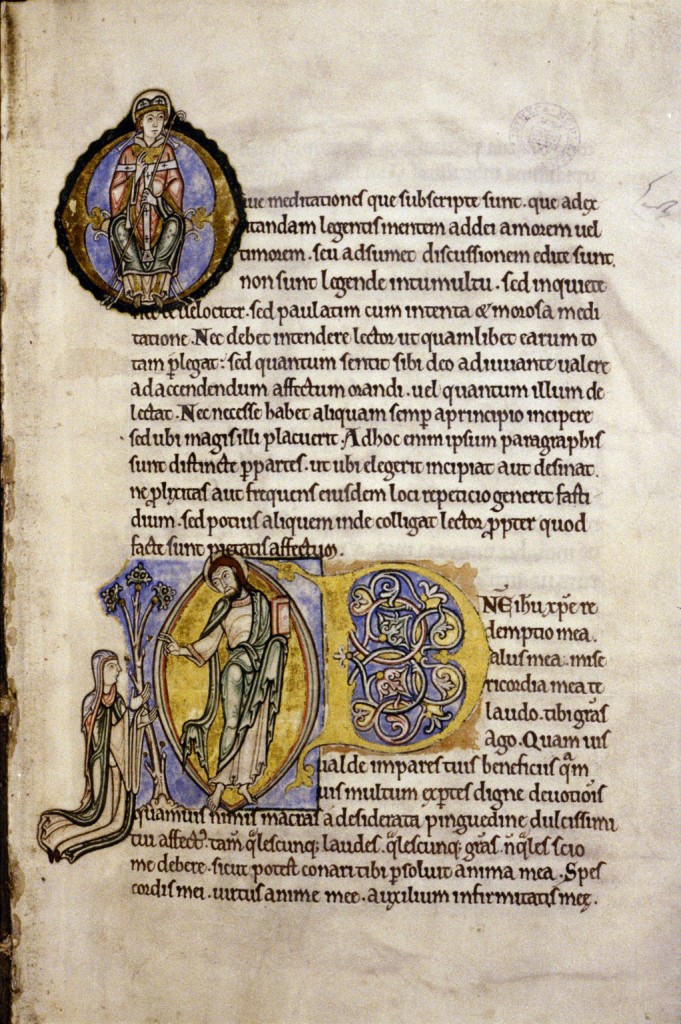
Bodleian Library, MS. Auct. D. 2. 6, folio 156r. Opening Page of Anselm’s ‘Prayers and Meditations’. Photo: © Bodleian Library, University of Oxford.
No fragment from this portion of the manuscript has re-surfaced, so far as I can tell. What are we looking for? That depends, perhaps in part, upon whether or not its layout, script, and embellishment conforms somehow to the other recognized parts of the book.
What if it comprised a subsequent addition, say on some originally blank leaves at the end of the book and/or on some inserted leaves containing, or extending, a supplementary text? Stranger things have happened. It was not uncommon for late-medieval manuscripts, produced in Flanders and elsewhere, to acquire augmentations to suit a new owner and/or new set of functions and expectations.
Because, so far, no leaves containing this short text have been identified from ‘Ege Manuscript 41’, it remains possible that they could have been lost without recognition because Ege’s generic title for the “Dialogues” of Gregory the Great obscured or derailed their recognition. Other factors, too, could be responsible. Who knows?
Division of Texts
Certain, at least, is that the text of the Meditations could not have occupied many of the 274 leaves of the former manuscript. The probable span of Gregory’s Dialogues in full, whatever it may have been, probably could not account for the lion’s share of the manuscript. These and other considerations permit us to conjecture that its majority concerned the various texts attributed to Chrysostom. The time has come to begin to consider them, now that our initial focus addressed the Dialogues.

Leaf 41, Recto, Top Right, in the Family Album (Set Number 3) of Otto Ege’s Portfolio of ‘Fifty Original Leaves’ (FOL). Otto Ege Collection, Beinecke Rare Book and Manuscript Library, Yale University. Photograph by Mildred Budny.
I. The Remnants of the Dialogues
One Leaf in Each FOL Portfolio, plus ‘Rogue’ Leaves Dispersed in Other Ways
The texts on some leaves in the manuscript have been identified already. Since then, I have been to add new identifications and some revisions to published identifications found on websites and in catalogues.
Among the Known leaves from the manuscript, counting both the specimens in the Portfolio sets (so far) and the Rogue Leaves (ditto), the texts of some of them are identifiable, at least insofar as they are visible to inspection and confirmation or, if applicable, revision. The leaves in some collections are not available to hand nor reproduced online. For some leaves, whether online or in print, only one side is reproduced, or only a portion of that side.
As Far As It Goes, and Beyond
As said, some belong to the Portfolios as their Leaf 41. Others are Rogue, that is, dispersed on their own, often, alas, without any proper documentation — not that Ege’s caption for the Portfolio can count as adequate documentation, as it masks, omits, or misrepresents some of the evidence. However, the details of the individual pages come in handy.
Reconstructing the Sequence of Leaves,
Leaf by Leaf, Book by Book, and Text by Text
Because the leaves were not numbered, we must proceed painstakingly by identifying the precise spans of text-per-leaf. My proposed reconstruction of the original sequence of some leaves remains provisional, updates included, as more identifications or revisions may well come to light.
Gregory’s Dialogues in 4 Books
So far, I have identified only a few leaves for all 4 Books of Gregory’s Dialogues. As the standard for the text, I use the critical edition by de Vogüé (1979), which has a facing French translation. Some out-of-copyright English translations are freely available online, for example here.
Assessing the span of text-per-column, -per-page, and per-leaf with respect to the printed text by de Vogüé (1979) allows for estimates of the extent of the losses between leaves. Nevertheless, we remain aware that the manuscript may have deviated in some ways from that printed standard. Certain discernible textual variations in the surviving portions both acknowledge and reinforce that awareness, as noted in our earlier blogpost on Otto Ege Manuscript 41.
As Here
The Lilly Library leaf, which provides the transition from Book II to the Chapter List of Book III, exhibits an attested variant in its presentation of the beginning of Book II, Chapter 38 — but not at Qui et in eo specu (as in the edition by de Vogüé, page 246, Line 1) but at Nuper namque (Line 3 instead). This variant is described as ‘init. cap. post coruscat’ [that is, after coruscat and starting at Nuper . . . ] in the editorial note on page 246, citing witnesses in an 8th-century Greek version and in some printed editions (Paris, 1705), etc. [unspecified]. These witnesses demonstrate the transmission of this choice in where to place the beginning of the Chapter as a ‘legitimate’ and widespread alternate. Nice!
Such features, recognized, may prepare the way for an understanding of the character of this copy of the Dialogues within the overall transmission of the text through the Middle Ages into the Modern World, albeit with curious detours along the way. It deserves its recognition in the stages of transmission. These Reports about ongoing discoveries about the dismembered manuscript offer contributions towards its better recognition.
Guidelines for a Virtual Reconstruction
In citing the location of passages within the Dialogues, my list highlights in Bold the corresponding Line Numbers in the printed text for the words with which a leaf begins or ends. This practice can more readily emphasize the direct flow (or not) between one leaf and another, and guide the places at which newly discovered leaves might be expected to begin or end, continuing the course of this copy.
My provisional reconstruction of the original sequence of leaves, as identified so far in divers locations, indicates where the text between leaves occurs in continuous order or has gaps as yet accounted for. Thus:
The text is continuous from one leaf to another, as their texts are identified, as highlighted in Red, thus:
> = Continuous textual order between individual leaves
The textual gaps are highlighted in Red, thus:
- GAP.
Likewise, denoting the end of quires, the catchwords are similarly highlighted in Red, thus:
- Catchword or Catchwords.
Provisional Reconstruction of the Sequence of Leaves for the Dialogues
I. Book I (12 Chapters)
With some gaps, the known text of this Book extends from the opening leaf to the penultimate leaf. Thus:
Set 3. Yale University, Beinecke Rare Book and Manuscript Library
Opening Title for the Dialogues
Non-Gregorian Prologue (giving a brief historical account partly derived from Paul the Deacon)
Chapter List for Book I in XII unnumbered Chapters, and
Some of the Prologue to Gregory’s Book I (amounting to 85 printed lines out of the 93 printed lines in total), ending in Section 10, Line 85 (per singula).

Recto of Leaf 41 in the FOL Portfolio. Otto Ege Collection, Beinecke Rare Book and Manuscript Library. Reproduced by permission. Photography by Mildred Budny.
[GAP of probably 1 leaf containing the remainder of the Prologue (corresponding to 8 more printed lines), all of Chapter 1 (68 printed lines in total), and the first part of Chapter 2 (42 printed lines in total)]
Set 13. University of MinnesotaBook I, Chapter 2, Section 4,Line 42 (iacebat) ‒ Chapter 3, 3, Line 26 (capite)
[The span of text amounts to some 130 printed lines for the leaf.]
>
Set 32. University of Colorado at Boulder recto and verso
1.3.3, Line 27 (perpendit) ‒ 1, 4.8, Line 97 (ferramentum)
>
Set 22. Cleveland Public Library
1.4.8, Line 97 (posuit) ‒ 1.4.18, Line 215 (tument)
[GAP of some 206 printed lines = say 2 leaves?]
Set 17. Massey College, The University of Toronto
1.8, 3, Line 24 (spatium vivendi signaverit) ‒ 1, 9, 7 Line 72 (in magnis quae + catchwords faciunt latere)
[GAP of some 120 printed lines = say 1 leaf]
Set 9. Cincinnati Public Library
1.9.17, Line 192 (Quae cum) ‒ 1.10.7, Line 84 (idcirco), illustrated here with permission.
The different photographs show the leaf on a white background (within Ege’s matted frame in my own photographs) and on a black background (as presented on the website of the Cincinnati Public Library of Cincinnati and Hamilton County). That we appreciate the value of the different images and backgrounds is made clear, for example, in our Style Manifesto, describing principles and practices for photographic images of manuscripts.
Because we understand the usefulness of paying attention to the different backgrounds (and also show-through) when photographing manuscript fragments, we present — with permission — views of the same leaf on black background as supplied on the Library website. Why should we care? What do we know? I invite you to inspect the illustrations of differences — let’s call it clearly “Night and Day” — as exhibited in our Style Manifesto,which displays another case in our exploration of Manuscript Studies.

From the Collection of The Public Library of Cincinnati and Hamilton County. Reproduced by permission.
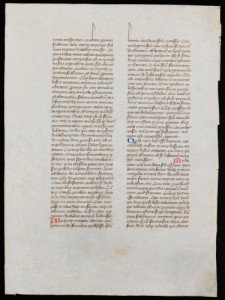
From the Collection of the Public Library of Cincinnati and Hamilton County. Reproduced by permission.
Recto
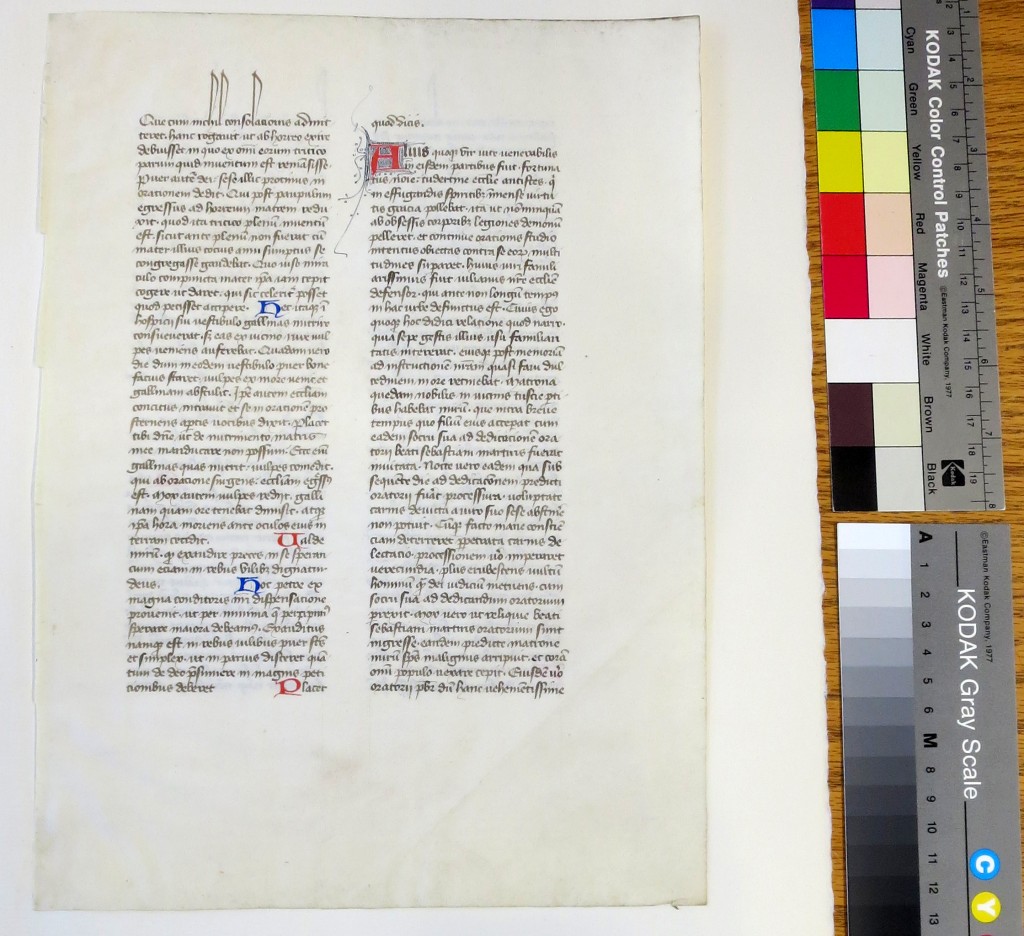
Cincinnati Leaf from Ege Manuscript 41, recto. From the Collection of The Public Library of Cincinnati and Hamilton County. Reproduced by permission. Photograph by Mildred Budny.
Verso
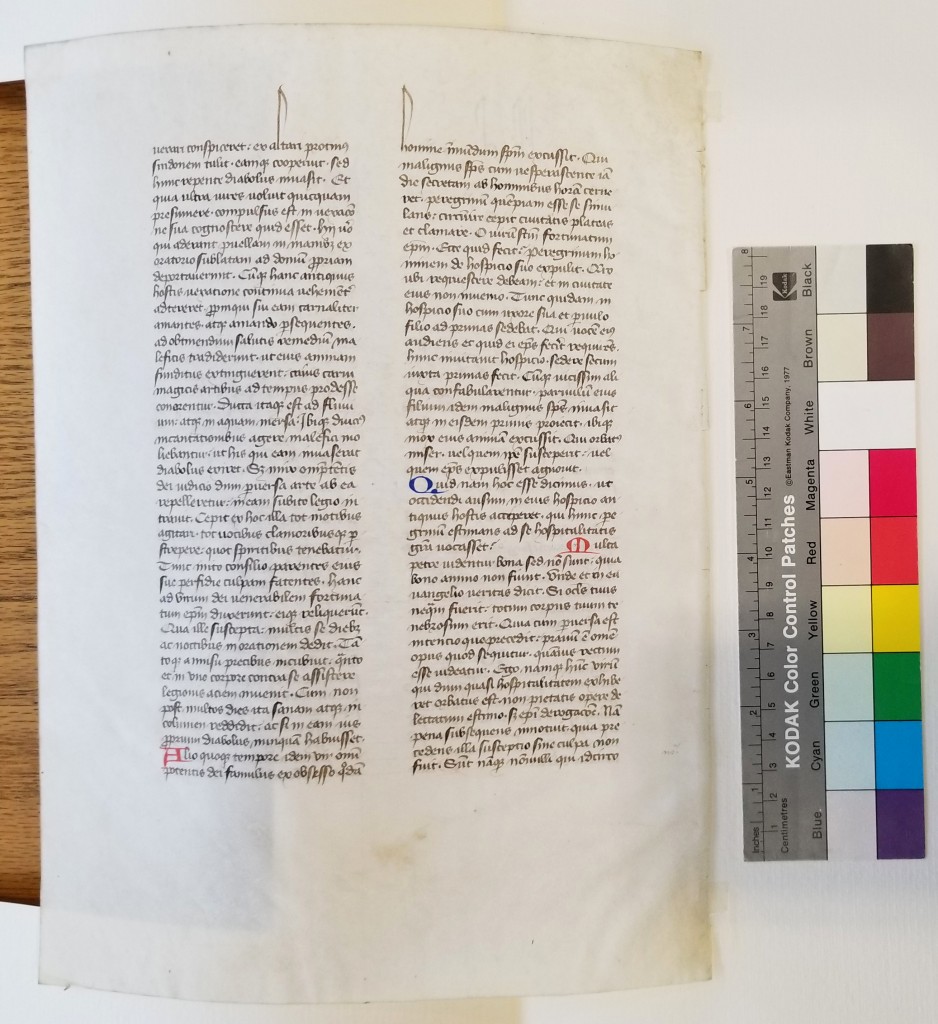
Cincinnati Leaf from Ege Manuscript 41, verso. From the Collection of The Public Library of Cincinnati and Hamilton County. Reproduced by permission. Photograph by Mildred Budny.
>
Set 4. Cleveland Institute of Art
1.10.7, Line 85 (bona facere) ‒ 1.10.17, Line 201 (omnipotentis dei )
>
Set 15. Kent State University
1.10.17, Line 201 (est cui) ‒ 1.12.1, Line 8 (ut acta de [for dei]) (recto) ‒ 1.12.6, Line 68 (ut esurientem me per),
coming close to the end of the Book
[GAP of 5 printed lines at the end of this Book]
Book II (38 Chapters)
[GAP to within Chapter 7.3]
Set 6. University of Massachusetts at Amherst (recto in black-and-white)
and now also Dialogi, ca. 1475 (recto but now in color)
Chapter 7, 3. Line 22 (contra Maurus) ‒ Chapter 8.4. Line 45 (inflammarent) on recto; span on verso = ?)
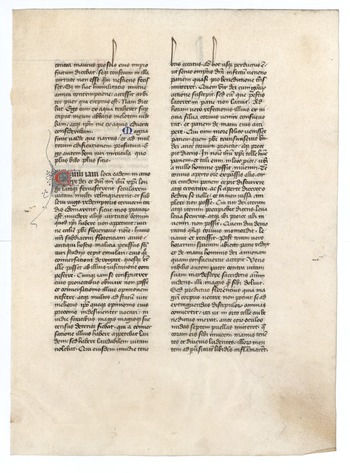
Dialogi, ca. 1475. Otto F. Ege, Fifty original leaves from medieval manuscripts. Special Collections and University Archives, University of Massachusetts Amherst Libraries
[GAP, number of leaves yet to be determined]
Rogue Leaf or Part of a Fragmented Portfolio?
Collection of the Paleographer Bernhard Bischoff (1906–1991)
Drewatts Bloomsbury (London), Western and Oriental Manuscripts and Miniatures Sale Catalogue (6 December 2017), Item 55 (page 50)
Chapter 32.1, Line 1 (Quadam die cum fratribus) ‒ Chapter 33.2, Line 16 (eadem sanctimonialis femina) + catchword soror eius
Despite the Sales Catalogue description of the contents, the illustrated (cropped) page of the leaf depicts this portion of the text, which stands on the original verso (attested by the catchword)
[GAP, number of leaves yet to be determined]
Set 24. Lilly Library of the Indiana University Libraries, Bloomington
Chapter 35.6, Line 55 (Fit uero ipsa) ‒ Chapter 38.5, Line 43 (end of Book II) + Book III, Chapter List 1‒6
>
Book III (38 Chapters)
[GAP. Chapter List for Chapters 1–6]
‘Rogue Leaf’ (Gwara, Handlist, No. 41.5) at Dartmouth College (illustrated here with permission)
Chapter List for Chapters 7–38, 3 lines skipped for title,
Prologue with elaborate decorated initial, and
Chapter 1, 1 (Line 1) with minor initial, to the first word of 1, 6 (Line 59) Factumque
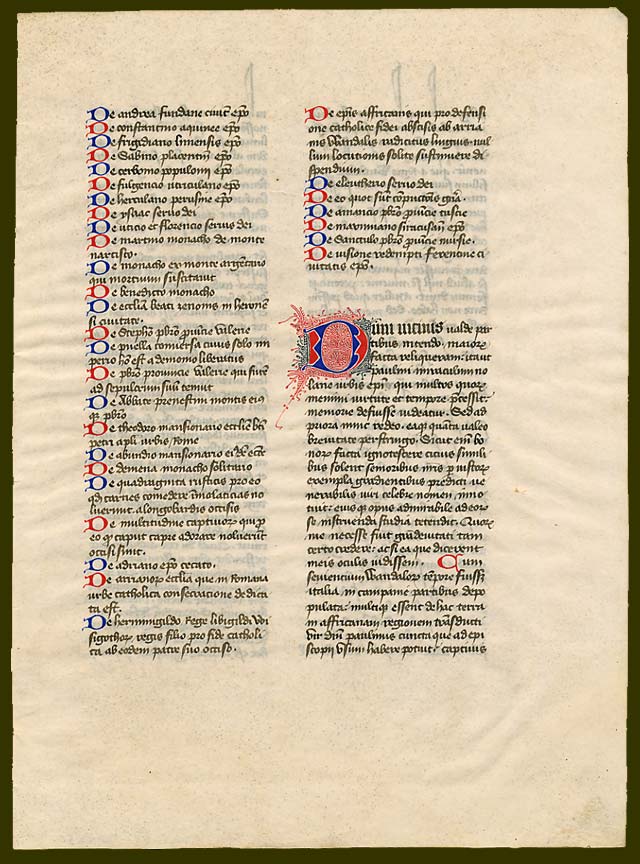
Dartmouth College, Rauner Library, MS 00226, Recto, with the end of the Chapter List and the opening of Book III of the Dialogues. Reproduced courtesy of Dartmouth College Library.
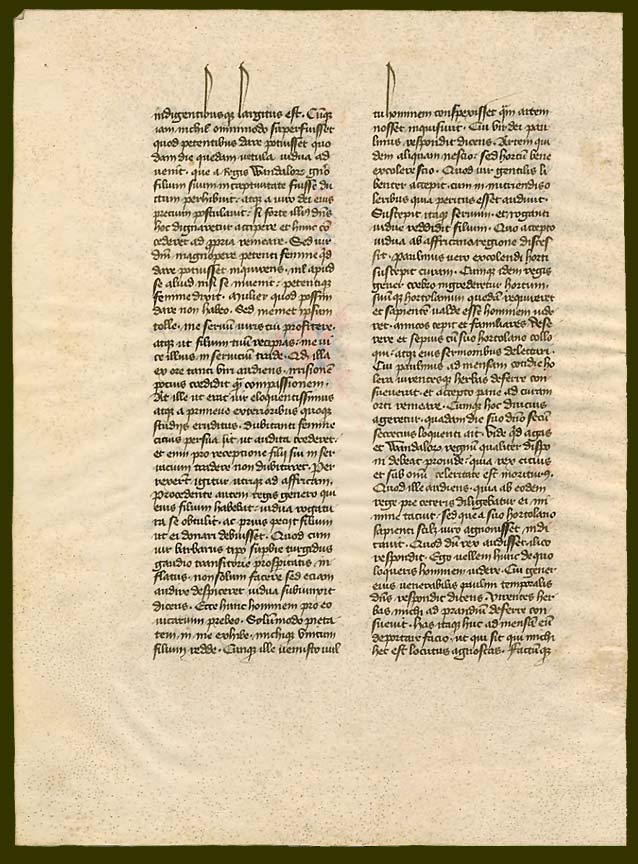
Verso with the continuation of Chapter 1 for Book III from ‘Ege Manuscript 41’. Dartmouth College Library, reproduced courtesy of Dartmouth College Library.
[GAP of numerous leaves from Chapter 1, 6.59 to 12, 3.23]
‘New Leaf’ as ‘Rogue Leaf’. Private collection (illustrated here with permission)
Chapters 12.3, Line 23 (intra eandem) ‒ 14.6, Line 60 (in ortum)
plus the catchword monasterii, evidently signalling the end of a quire

Recto of Detached Leaf from ‘Otto Ege Manuscript 41’ (with the Dialogues of Gregory the Great, Book III, Chapters XII-XIV. Private Collection, reproduced by permission.
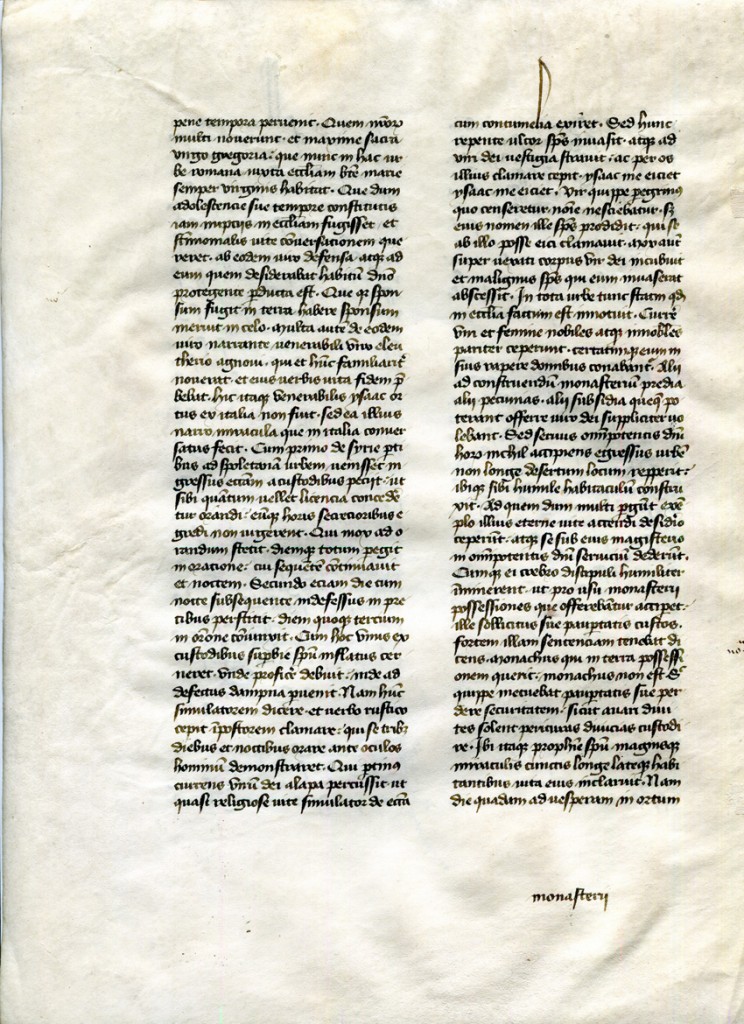
Verso of Detached Leaf from ‘Otto Ege Manuscript 41’ (with the Dialogues of Gregory the Great, Book III, Chapters XII-XIV. Private Collection, reproduced by permission.
[GAP of numerous leaves from Chapter 14, 6.60 to 15, 8.70]
‘Rogue Leaf’ sold through Maggs Bros. Whereabouts unknown.
One page (recto or verso?) illustrated in Plate XXXIII for Maggs Bros European Bulletin No. 11: Manuscript Leaves, Illumination & Calligraphy, Also Early Writing from Egypt (November 1982), item 88 allows this identification:
Chapters 15,8, Line 70 (quantolibet dolore commotus) ‒ 15,16 Line 131 (quam tangit quia dum)
[With the other side of this leaf presenting a comparable span of text either preceding or following this portion]
[GAP of numerous leaves from Chapter 15, 16.131 to 36, 3.18]
Set 27. University of South Carolina, Early MS 41a [=Early MS 41, folio 1]
Chapters 36, 3, Line 18 (Rimis) ‒ 37, 10, Line 87 (morte illius)
[GAP to Chapter 38, 5.58 at the end of the Book]
Book IV (59 Chapters)
[GAP to Chapter 4, 9.82]
Set 23. Kenyon College in black-and-white (via ege.denison.edu),
and now Dialogues of Gegory the Great: Number 41 in color (via digital.kenyon.edu)
Chapter 4, 9, Line 82 (quod requivisui) – 7, 1, Line 9 (quatenus fluctuanti)
[GAP of numerous leaves to the end of the Book and the Dialogues]
*****
Chapter Titles and the Openings of Books and Chapters
With the revelation of the Ege Family Album of FOL, there emerges the first leaf of Book I, with its chapter list and opening initial. Also known are the first leaves of Book III of the Dialogues and of one of Chrysostom’s Homilies (see below).
In its portion of the Chapter List, the Dartmouth College leaf records the titles (without numbers) for those chapters in Book III which appear in whole or in part on the newly recovered leaf, so that we might discern their intended wording for the lines skipped within the text for each Chapter title, and so supply those for the chapters on the new leaf from the manuscript itself:
- [III, 12.] De Fulgencio Utriculanae civitatis episcopo (‘On Fulgentius, Bishop of Utricoli’ [[Otriculi]) near Orte in Umbria)
- [III, 13.] De Herculaneo Perusinae civitatis episcopo (‘On Herculanus, Bishop of Perusium‘, now Perugia)
- [III, 14.] De Isaac servo Dei (‘On Isaac, the Servant of God’)
With the space of 3 lines skipped for an opening title between the Chapter List and the Prologue, the opening initial for the Prologue of Book III (rb16–19) receives especial emphasis. It has a taller decorated initial of 3-line height and bichrome decoration, alternating blue and red pigments not only between the different elements (initial, extended penwork), but also within each of those elements.
Chapter 1, in contrast, opens with a simple 1-line initial (rb33), in the form of initial used within the Dialogues portion mostly for the interlocutors’ questions within chapters. That approach appears, for example, on the new leaf for Peter’s unattributed question which starts within line rb33.
It is worth noting that such variations within the seemingly standard presentation of the texts across the different pages and leaves should caution the wish to make fixed assumptions about how the missing or so-far unrecognized leaves accomplished their individual presentation in the flesh. The details and their variations matter.
Textual Variants as Signifiers

Top of verso of Leaf from Ege Manuscript 41 at the University of Colorado at Boulder, reproduced by permission.
One might wonder if this feature — an ‘omitted’ passage supplied in the margin by the same scribe as the main text, set within a simply embellished frame having scalloped inner contours, and equipped with a time-honored, perhaps by then out-of-date, form of signes-de-renvoi — represents the scribe’s more-or-less faithful representation of that manuscript (now lost, or lost track of) which served as his exemplar for transcription. If so, could we think of the exemplar as perhaps representing more directly, overall, a considerably earlier century in the transmission of the text? The critical edition (listing very few manuscript variants) cited above does not help here, so other forms of research might be required.
The Manuscript as a Whole
In the original manuscript, the Dialogues stood with, at least, some Homilies (in Latin) by or attributed to John Chrysostom (circa 349 – 407 CE), Archbishop of Constantinople. Both the Census published in 1937 and the medieval contents list at the front of the manuscript list the former order of the texts, in which the Dialogues composed by (or ‘by’) Gregory the Great came first and the Meditations of Anselm came last, sandwiching the texts by, or purportedly by, Chrysostom.
With the dispersed leaves, the order of texts would be difficult to identify on their own. As if it is not difficult enough already. However, we press on.
The Census Record of the Manuscript Before Dispersal
Whether the count of ‘274’ folios included endleaves (if any) or solely considered leaves with text, if (as seems likely) the list of texts simply represents a summary contents list in the book (‘etc’), and what was the span of folios for each portion of the texts. At least the contents list tells us something, however incomplete.
In the volume, the Dialogues in all ‘IV Books’ stood with, at least, some works by or attributed to
- John Chrysostom (circa 349 – 407 CE), Archbishop of Constantinople, and
- Anselm (circa 1022 – 1109 CE), Archbishop of Canterbury.
Listed here for the Greek author Chrysostom are his Epistles and his Commentaries on the Epistle of Paul to the Hebrews (translated into Latin), and another text or other texts (‘etc’). They belong to the corpus of works in Latin by or attributed to Chrysostom, known generally as Chrysostomus Latinus (“The Latin Chrysostom”). I have not seen (directly or indirectly) any leaves from Anselm’s Meditations and Prayers. The catalogue description for one of the Oberlin College leaves identifies its text as a Sermon by Augustine of Hippo
A future investigation of all the texts as represented on the Known leaves (Portfolio + Rogue Subset 1) might reveal more of the survivals from the full set of 274 folios cited in the Census. In that set, the Dialogues stood with, at least, some Epistles and Homilies (translated into Latin) by or attributed to John Chrysostom (circa 349 – 407 CE), Archbishop of Constantinople, and (on one of the Oberlin College leaves) by Augustine of Hippo. Long way to go.
The Census of 1939 (anyway printed in that year, who knows when sent to the printers, let alone when the texts were completed) lists the former order, as we soon see. Perhaps — although by now I come to think ‘Probably’ — its list takes the words from a Contents List within the Book.
If so, it is useful to keep in mind the ways in which medieval contents lists — in their infinite variety — managed to summarize and dismiss the books in their purview, moving concisely from one to the next, and beyond, in recording the contents of books both within or upon their own covers (say on a front flyleaf, if available, or on a cover itself) and in a library inventory or catalogue. Specimens of Contents Lists in 15th-century manuscripts exhibit a tendency toward concision. Not conducive in every instance to ensuring a full list of the different texts in a ‘composite’ manuscript.
Valuable as it is for information about the original manuscript before its despoliation, the Census record leaves too much to be desired. Still, it is what it is (whatever that is), and its evidence commands attention. That it gives us scraps might, in a sense, be fitting, because the manuscript itself now survives only as scraps, whether as single leaves, bifolia, or larger remnants.
And so, 274 leaves (according to the Census) as a whole remain the goal for full accounting. Other scholars may wish to pursue this quest more fully. I offer this step as a point for continuation.
Catchwords at the Ends of Quires
That the surviving leaves — so far as I have seen — do not carry page- or folio-numbers (unlike some other manuscripts in the Portfolios) nor running titles (ditto) means that a reconstruction of their original series in the book must rely principally upon the chance to identify specific portions of the texts themselves, particularly where the flow from one leaf to another and from one text to another can be demonstrated. In any case, the list of 3 named authors’ texts in the medieval contents list and in the 1937 Census allows us provisionally to discern their order, no matter how shuffled the leaves may now seem in their redistribution.
A few catchwords have emerged into view. So far, 3 leaves within the Dialogues (Books I, II, and III respectively) carry a single word or a phrase low-set in the bottom margin of the verso, below column b of the 2-column text. They may aid our reconstruction of the arrangement of leaves within some quires, perhaps to reveal a consistent practice.
While the practices of entering catchwords at the ends of leaves or at the ends of quires continued to evolve through the latter part of the Middle Ages and into the Age of Print, the presence of a catchword on a single leaf within a dispersed, and otherwise unknown, manuscript would not suffice to permit confidence about its choice for positioning catchwords as aids to link together the different construction components of a manuscript for its assembly into the completed volume or quire.
Catchwords so far:
- Set 17. Massey College, The University of Toronto
Catchwords faciunt latere in the Dialogues, I.9,7, Line 72 - Rogue Leaf? Leaf from the Collection of the Paleographer Bernhard Bischoff (1906–1991).
Drewatts Bloomsbury (London), Western and Oriental Manuscripts and Miniatures: Sale Catalogue (6 December 2017), Item 55 (page 50)
Catchwords soror eius in the Dialogues, II.33, 2, Line 16 - Rogue Leaf. ‘New Leaf’. Private Collection
Catchword monasteri in the Dialogues, III.14,6, Line 60
Perhaps, with more discoveries, it might become more readily possible to assess the probable number of leaves, and quires, which the Dialogues portion of the manuscript required.
The Opening
Now,as we tackle the Chrysostom portion of the volume, the list groups the identified leaves into a provisional reconstructed sequence according to different segments of its texts. Those segments are arranged, insofar as the fragmented evidence permits, into 2 Groups.
- Identified sequences. The opening title (on the leaf now at the Reading Public Museum) identifies Chrysostom’s Epistle(s), starting with the Epistle to Theodore. Other leaves find their order according to the series of Sermon titles as presented in the manuscript.
2. So far unidentified. A different group gathers the leaves presumably or apparently from that portion whose texts have not yet been identified.
Group I. Chrysostom’s Epistle(s) and Sermons on the Epistles to the Hebrews and Other Texts
The reports of this section of the manuscript provide different descriptions of its contents. So far, these reports comprise
- the Medieval Contents List at the top of the first page of the manuscript
- the 1937 Census
- the opening title for this section on the leaf at the Reading Public Museum
- the various titles throughout this section on its identified leaves.
Which means that an understanding of the precise characteristics of this section await further information, as it might be uncovered.
Texts and Contexts
Clearing some ground for the work on this section, I set forth a few references which establish contexts and bearings. A variety of Latin translations from texts by, or presumably by, John Chrysostom, stretch across divers regions from the Early Christian period onward. Among them are translations of various of his Epistles or Homilies/Commentaries on many Books of the Bible, Old and New Testaments alike.
The ‘Chrysostom’ portion of Ege’s manuscript included some of these, and other, texts. When more of the dispersed leaves come into view, we could gauge its testimony as a witness to the transmission of such texts.
For this quest, we might ground the exploration with reference to some selected resources, among many, which examine Chrysostom himself, his own time, the Latin translations of his works (or presumed works), some of his Latin translators, and a medieval collection of 38 of his (and ‘his’) Latin Homilies and Epistles which circulated in various centers, with some variations.
- Chrysostomus Baur, Johannes Chrysostomus und seine Zeit (Munich, 2 volumes, 1929–30),
with an English translation in John Chrysostom and His Time (Westminster, 1959–60) - Jean-Paul Bouhot, “Les traductions latines de Jean Chrysostome du Ve au XVIe siècle”, in Traduction et Traducteurs au Moyen Âge. Actes du colloque international du CNRS organisé à Paris, Institut de recherche et d’histoire des textes les 26–28 mai 1986 (Paris, 1989), pages 31–39
- Pierre Courcelle, Les Lettres grecques en Occident. De Macrobe à Cassiodore (Paris, 2nd edition, 1948), pages 376–77
- E.A. Lowe, “An Uncial (Palimpsest) Manuscript of Mutanius in the Collection of A. Chester Beatty,” Journal of Theological Studies, 29 (1928), pages 29–33
- André Wilmart, “La collection de 38 homélies latine de saint Jean Chrysostome”, in Journal of Theological Studies, 19 (1917–18), pages 305–27
- Roger Pearse, The Translations of Chrysostom into Latin — 5. The Collection of 38 Homilies
- Jean Chrysostome, A Thédore: Introduction, Text Critique, traduction et notes par Jean Dumortier, Sources Chrétiennes, 117 (Paris, 1966), especially pages 30–34 on Latin translations of the Epistle to Theodore (beginning Si fletus posset = Wilmart (1917–18), number 30
Leaves so far identified include the opening page of the Chrysostom section and some others at different points in its course.
The Chrysostom Section
As the pieces emerge into view, the structure, contents, and characteristics of the ‘Chrysostom’ portion become clearer.
I. Chrysostom’s Epistola [II] ad Theodorum Monachum
Handlist 41.7. Reading Public Museum (reproduced in Gwara, Otto Ege’s Manuscripts, fig. 22, cropped to lines 1–19 in one column — but without specifying which column and which side of the leaf)
With thanks to Ashley J. Houston, Collections Manager at the Reading Public Museum, while the leaf is part of a traveling exhibition, I have been able to see images of the text on both sides of the leaf.
The recto presents the opening title for Chrysostom’s Epistole et Expositiones . . . super Epostolam ad Hebros quorum aliis, starting with his Epistle [or Epistle II of 2] to Theodore, which begins Si fletus possent. Within the pair of epistles which Chrysostom addressed to the monk Theodore “after his Fall”, this text constitutes Epistle or Letter II.
The recipient was Theodore of Mopuestia (circa 350 – 428 CE), that is, Theodore the Interpreter, bishop of Mopsuestia (as ‘Theodore II’) from 392 to 428 CE. The subject-matter
The rubricated title specifies its text thus:
Incipiu[n]t ep[isto]le et exp[ositio]nes s[anc]ti Ioh[ann]is ep[iscop]i constantenopo[lis] . tam sup[er] ep[isto]lam ad hebreos cum al[ii]s. Et primo ad Theodoru[m] qui deseruevat religionem Incipit ep[istol]a p[r]ima s[anc]ti Ioh[ann]is Chrisostomi —
[Here] begin the Epistles and Commentaries of Saint John, Bishop of Constantinople, so much as On the Epistles to the Hebrews, together with Others. And at first [is the One or are the Ones Addressed] to Theodore, who had abandoned the religious life. [Here] begins the first Epistle of Saint John Chrysostom
Beginning Si fletus possent (“If it were possible [to express] tears”), this text comprises Chrysostom’s Letter II to Theodore (Epistola ad Theodorum monachum, corresponding to Palaeographi Graeca, volume 47, column 309 etc). Its critical edition appears here:
- Jean Dumortier, in Jean Chrysostome, A Thédore: Introduction, Text Critique, traduction et notes par Jean Dumortier, Sources Chrétiennes, 117 (Paris, 1966), at pages 241–256 (in 6 numbered Sections, amounting to 446 lines of printed text)
English translations appear freely online via here and An Exhortation to Theodore after His Fall
The span on the leaf extends from the opening title, through all of Dumortier’s printed Section 1 (in 89 printed lines) to the first lines of his Section 2 (to printed line 10 on page 244), ending with verum / [/mox ad medicum]. Altogether corresponding to some 99 printed lines.
We await the identification of the next leaf from this Epistle, whose printed Sections (in 89 + 64 + 100 + 68 + 84 + 31 lines) equal 445 printed lines. Which means that the Theodoran Epistle, if complete in the manuscript, extended for, say, some 4 and one-half leaves altogether.
II. Chrysostom’s Commentaries or Homilies on the Pauline Epistles to the Hebrews
Several leaves present portions of this text.
Working with limitations of access to library resources (despite paying a high price annually anyway), I progress as and when I can. We hope for help. [Donations for our Director’s Access to Expensive and Exclusive Libraries remain, year after year, on on our Wish List. Still Waiting. Please help if you can.]
Meanwhile, I offer these developments, as and when.
FOL Set 8
The Newark Public Library, shown here, with the opening of Quartus sermo eiusdem Cristomii (“The same Chrysostom’s Sermon IV’) beginning Fide obtulit = Homily XXV on Hebrews 11:17–17.
Note no colored yellow wash for initial letters.
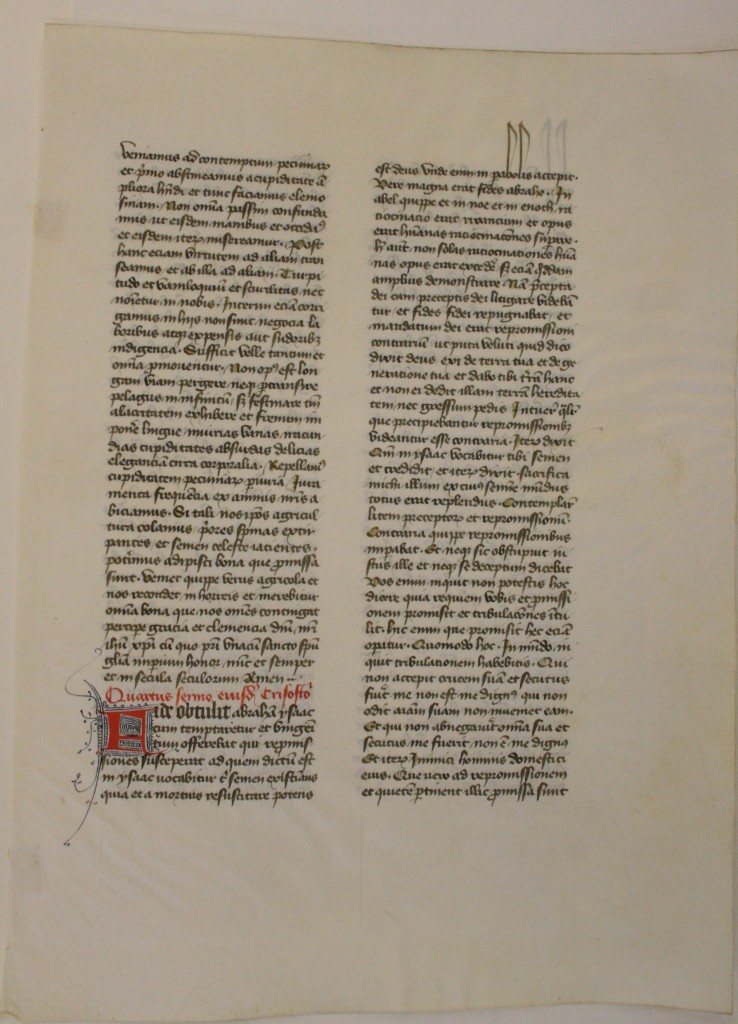
Recto of Leaf in Portfolio 8. Special Collections Division, The Newark Public Library, reproduced by permission.
- FOL Set 28 (The Morgan Library & Museum, B2 093 B MS M.1021.1-50) with the title for the duodecimus sermo crisostomi (“Chrysostom’s Sermon IX”)
- Handlist 41.4 (University of South Carolina, Early MS 41b [= Early MS 41, folio 2]), containing Chrysostom, Epistola ad Hebreos, XI = Homilia XXVII, [ad]/ ipsam mortem venianis . . . circa ipsam mortem praeualit / [fides/], beginning Ante Eius .
- FOL Set 25 (University of Saskatchewan) with duodecimus sermo crisostomi (“Chrysostom’s Sermon XII”) beginning Propterea
- FOL Set 35 (Rochester Institute of Technology and now also here on the library website, verso only), with the end of Chrysostom’s Homily XXVIII on Hebrews 12:1 and the beginning of his Homily XXIX on Hebrews 12:4, with Ottavus sermo eiusdem Chrisostomi (“The Eighth Sermon of the same Chrysostom”)
III. Chrysostom’s Epistles or Homilies on Psalm 50
The leaf in the Lima Public Library carries the opening title for Chrysostom’s Commentaries on the Psalms. The preceding text presents the end of a different sermon
Texts with Opening Titles
Some identified leaves carry not only the openings of texts — Books in the Dialogues, Epistles, Sermons, or Homilies in the Chrysostom Portion, and so on — but also their opening titles. Such readers’ guides ease some of the path of identifying and reconstructing the original contents, as well as, to an extent, their original sequence.
We have examined the Dialogues already, insofar as the recognized survivors permit. With some of that ground cleared, and as more research on the manuscript overall advances, the time has come to consider the Chrysostom portion more clearly. There is more work to be done, but some pointers emerge.
Chrysostom’s Homilies on Psalm 50
Within the collection of 38 Homilies of the Latin Chrysostom, that set of Homilies on Psalm 50 normally appears as Items 1–2 = In Psalmum 50 homiliae 1-2 (PG 55, 565-588).
- FOL Set 29 (Lima Public Library) with the rubric Incipit liber primus beati Joh[ann]is Crisostomi sup[er] Psalmo misere mei deus, (“[Here] begins Book I of the blessed John Chrysostom On Psalm [50], ‘Miserere mei deus’ “), preceded by the end of a sermon corresponding to the edition by François J. Leroy (1999), pages 177, line 68 (prouocata fuerat) – 178 line 98 (sit reparari) + an additional sentence not found in that “provisional edition” of a collection of sermons in Latin translation from Greek, introducing Pictores imitantur arte naturam (Homilia in Psalmis = Patrologia Graeca, volume LX, columns 565ff.)
Other Texts by Chrysostom
Distributed in several ways (among others):
FOL Sets
- FOL Set 30 (Denison University), with one of Chrysostom’s 3 Homilae de cruce et latrone
- FOL Set 37 (Case Western Reserve University)
‘Rogue Leaves’ of Gwara, Handlist
- Handlist 41.6 (Oberlin College), comprising a bifolium of 4 leaves with one of Chrysostom’s Sermons and with Augustine’s Sermones ad fratres in eremo commorantibus, including Sermon 76 in full and the opening part of Sermon 73 (homo est quid)
- Handlist 41.8 (Winthrup University).
- Section 10, Line 85
And There’s More. Watch This Space, now that we focus on the Chrysostom Portion.
III. Anselm’s Meditations
So far, no leaf from Anselm’s Meditations from this manuscript has surfaced. One might wonder why. By now, I begin to think that its text and layout, especially if not ‘worthy’ of mention (according to Ege), could represent the work of some other scribe(s). If so, it could be difficult, to say the least, to recognize the connection with Ege Manuscript 41.
The Road to Dispersal and Virtual Recovery
The elements of recorded provenance suggest, but do not prove, that the manuscript remained for several centuries within the region of its production, in the 15th century in Flanders. The absence of many titles for chapters in the lines which the scribe skipped so as to make way for their entry in contrasting red pigment gives an appearance of incompletion, as do the gaps left within the lines of text for the speakers’ names in parts of the Dialogues. Nevertheless, the skilled script and expert penwork flourishes of the decorated chapter or section initials demonstrate polished workmanship.
It may become possible in time to identify the scribal artist(s) responsible for this workmanship in other manuscripts from the region, so as better to locate the center and individual(s) involved. Parts prepared by other scribes remain possible, given the gaps in our knowledge. Publishing more pages from the volume may aid and accelerate that process.
Collating the evidence for the stitching holes for the binding(s) upon the severed leaves of the surviving manuscript might cast light upon the history of its binding(s) before the forcible severance, sometimes by uneven jagged cuts, sometimes by tears, which released the leaves unto their new, separated fates.
Prices of Dispersal
This book is said to be one of the several — top four at current count — ‘most widely dispersed’ of Ege manuscripts (Gwara, Otto Ege’s Manuscripts, p. 72). According to records of sales from this volume, a leaf from it cost $2 in 1944, another cost $3.50 in 1952, and another belonged to an 8-leaf set for sale for $25 (Ibid., pages 72 and 348).
The Chrysostom leaf at the University of South Carolina (Early MS 41b), which joins online the Dialogues leaf in Set 27 of the FOL Portfolio in the same collection (Early MS 41a), carries traces of its journeys after detachment from the volume. Pencil inscriptions on its bottom recto record the original price of the leaf (‘$1.—’) and on the verso a price in pounds sterling (‘£100′ + ‘VAT’, citing Value Added Tax applicable after the adoption of that charge in the United Kingdom on 1 April 1973). The form of the original price resembles that on some other known Ege ‘Rogue Leaves’, illustrated, for example, here. The secondary price attests to travels through a dealer in the United Kingdom.
The journeys of other leaves from the book are sometimes indicated in book-sellers’ or other catalogues (listed in part in Gwara, Handlist, No. 41) and in the records in various collections of the gifts or purchases of the Portfolios and of some ‘Rogue’ leaves. Some leaves retain direct signs of their passage beyond the volume, as with seller’s marks or, in some cases, Ege mats. Other leavess require other means, of some kind or other, to give voice to their enforced silence and to render possible a recognition of their ‘birth family’ and many siblings in the original volume.
As of November 2017, a leaf from the teaching collection of the late palaeographer Bernhard Bischoff calls for a much higher price at auction. The Bischoff Leaf from Book II of the Dialogues in this manuscript is estimated at £400–600. Yikes.
Not to mention the prices, also known as cost, in terms of lost or derailed historical understanding about the original manuscript. Priceless.
Progress
This post offers a contribution to the quest to prepare a ‘Foundling Hospital’, if only in virtual form, for the orphaned leaves and other discarded remnants from the manuscript. We are making Progress, don’t you think? Slowly but Surely.
Perhaps you know of other leaves from this book? Please join the quest to recover fuller knowledge of the survivors.
You could leave a comment here, Contact Us, or converse with us on our FaceBook Page.
*****
ThanksGiving
For help with inquiries about the materials in their collections and permission for reproduction of images, we gladly thank the staff in the libraries of
The Beinecke Rare Book and Manuscript Library
The Public Library of Cincinnati and Hamilton County
University of Colorado Boulder Libraries
Dartmouth College
Kent State University
Lilly Library
The Morgan Library and Museum
The Newark Public Library
Cary Graphic Arts Collection, Rochester Institute of Technology
Reading Public Museum
Special thanks are recorded to Raymond Clemens (Beinecke Rare Books and Manuscript Library), James Mainger (Cincinnati Public Library), Gregory Robl (University of Colorado), Peter Carini and Morgan Swan (Dartmouth College), Amanda Faehnel (Kent State University), Zach Downey (Lilly Library), Nadine Sergejeff (Newark Public Library), Roger Wieck (The Morgan Museum & Library), Ashley J. Houston (Reading Public Museum), and Stephen K. Galbraith (RIT Cary Graphic Arts Collection).
It is a pleasure to find such professionalism, enthusiasm, and generosity in these communications.
We thank the owners for the opportunity to study and to reproduce the leaves.
Do you know of more leaves from this manuscript? Please let us know.
Next we report on some other ‘Lost and Foundlings’. Please visit our blog’s Contents List”.
*****
Update on 18 June 2020: Now see Some Leaves in Set 1 of Ege’s FOL Portfolio — including from ‘Ege Manuscript 41’!
*****

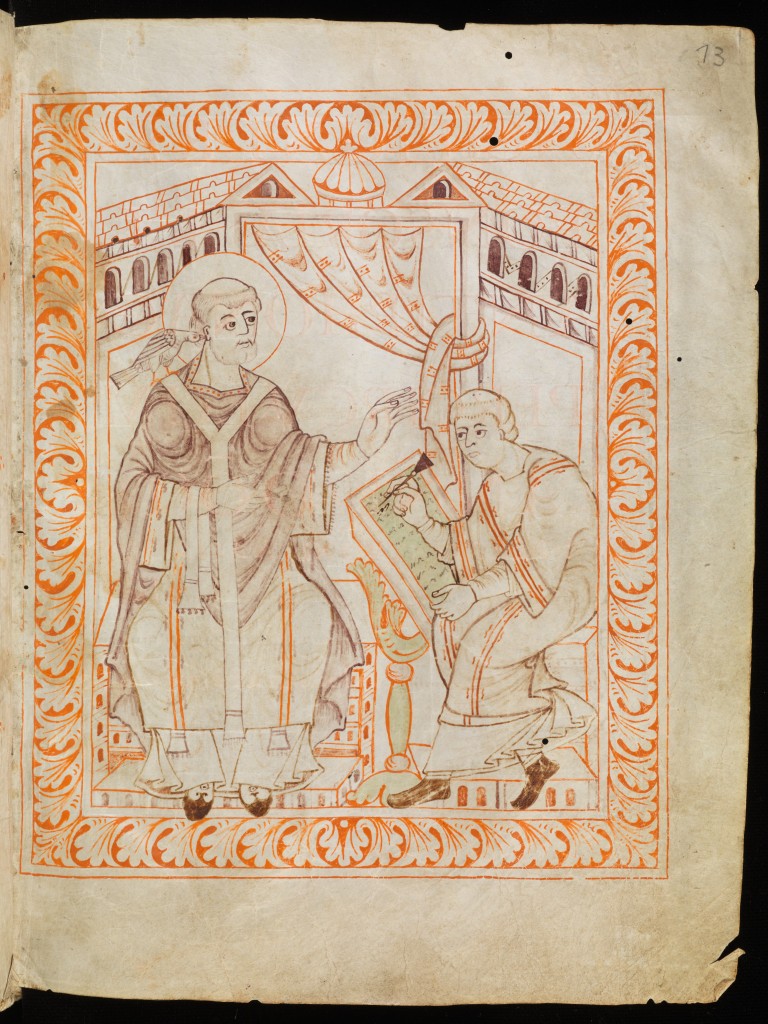
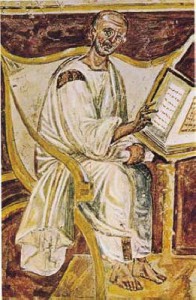
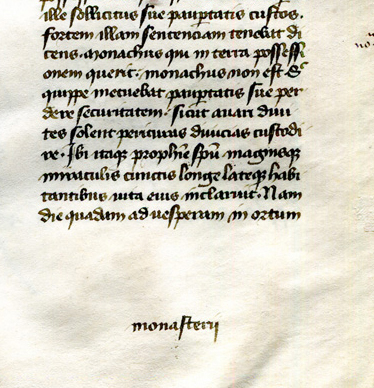
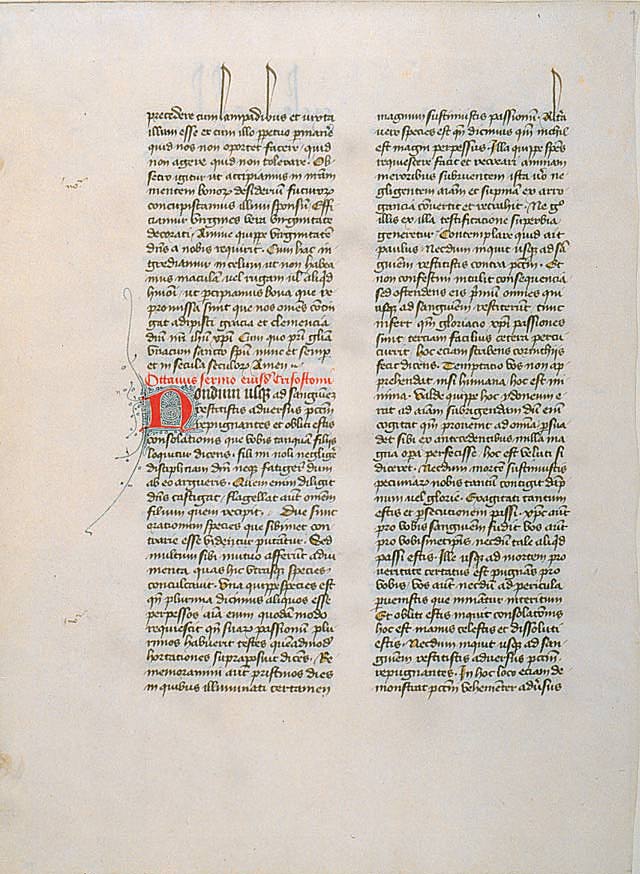
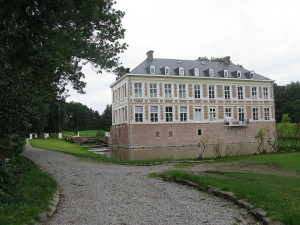
[…] Ege FOL 41: Mildred Budny has written about this manuscript here. […]